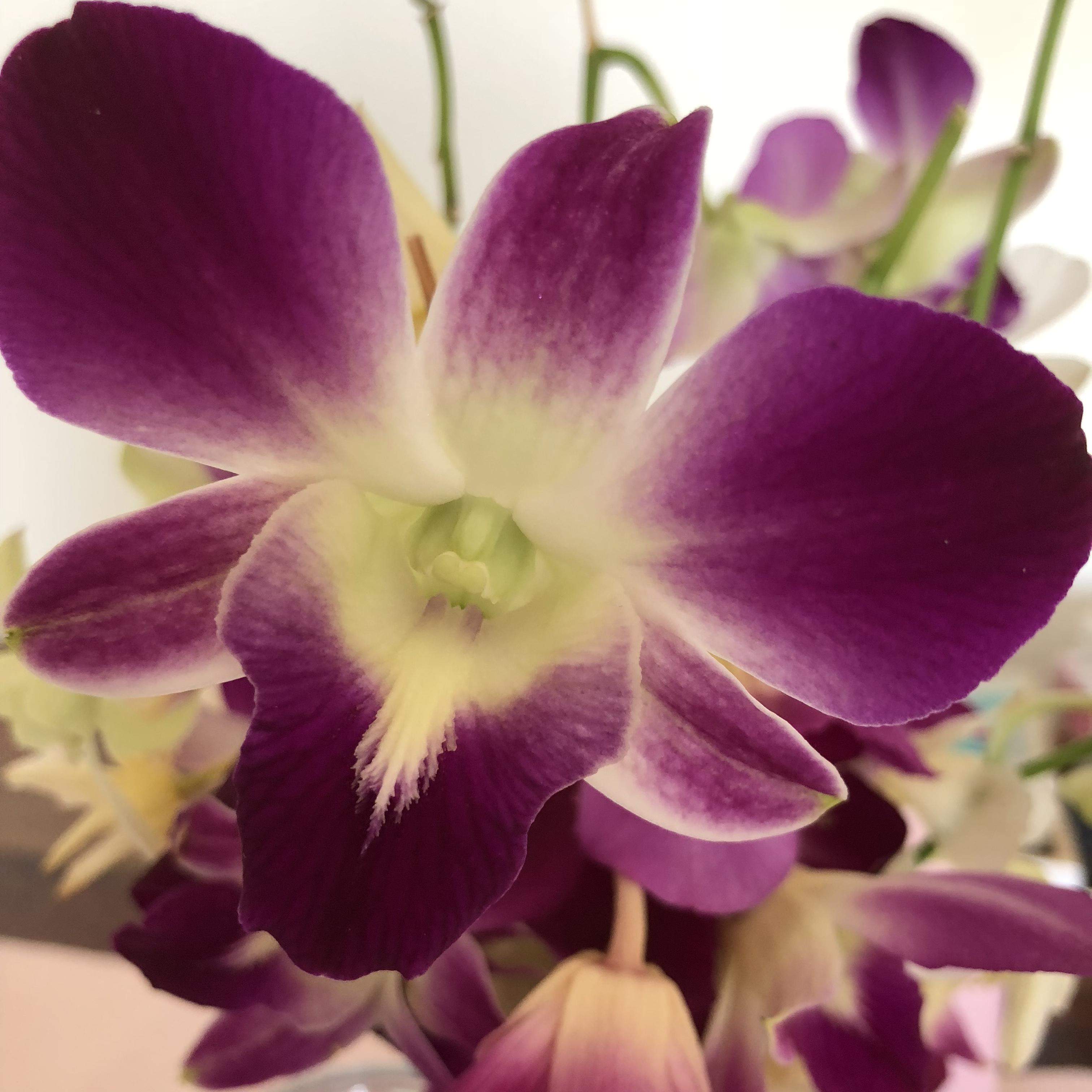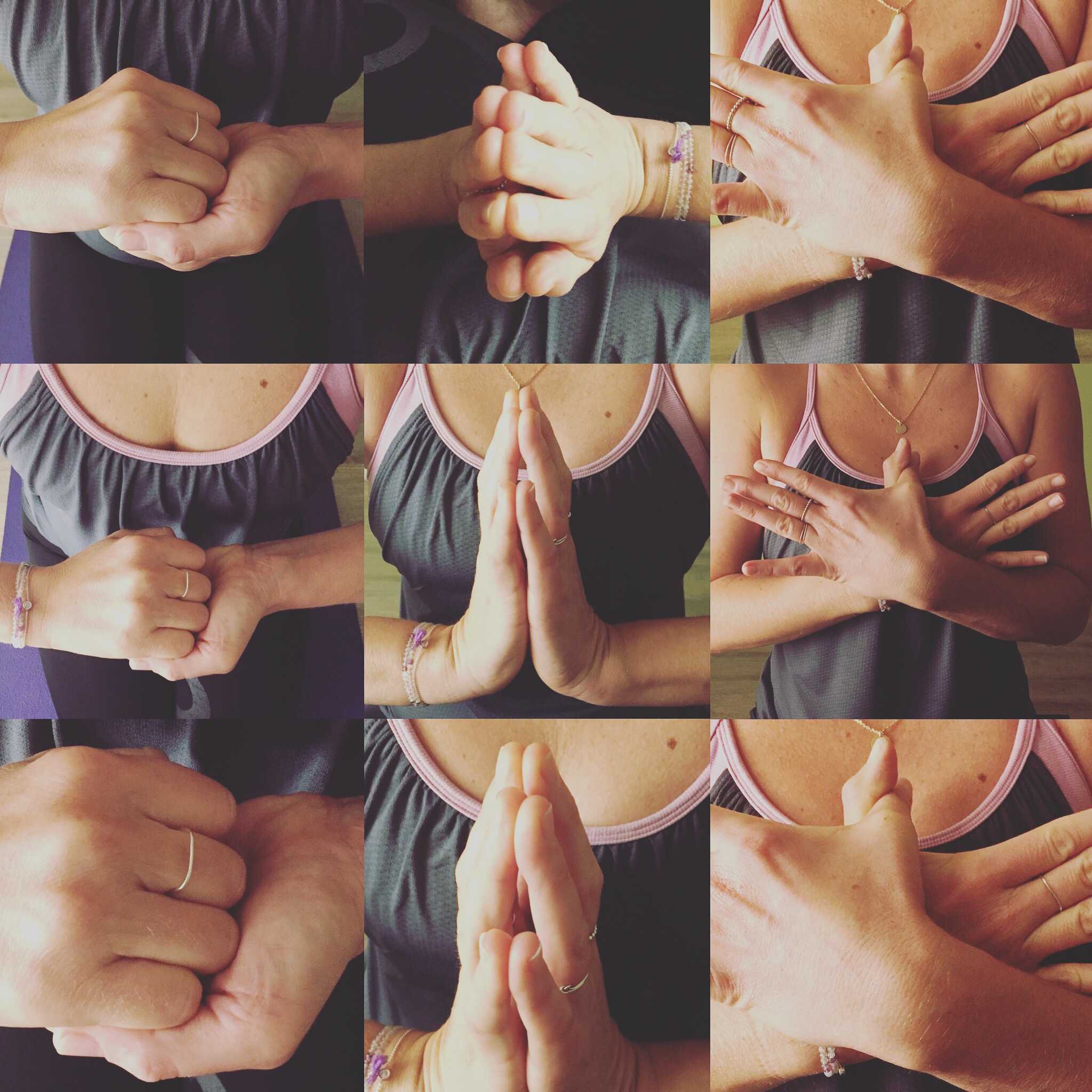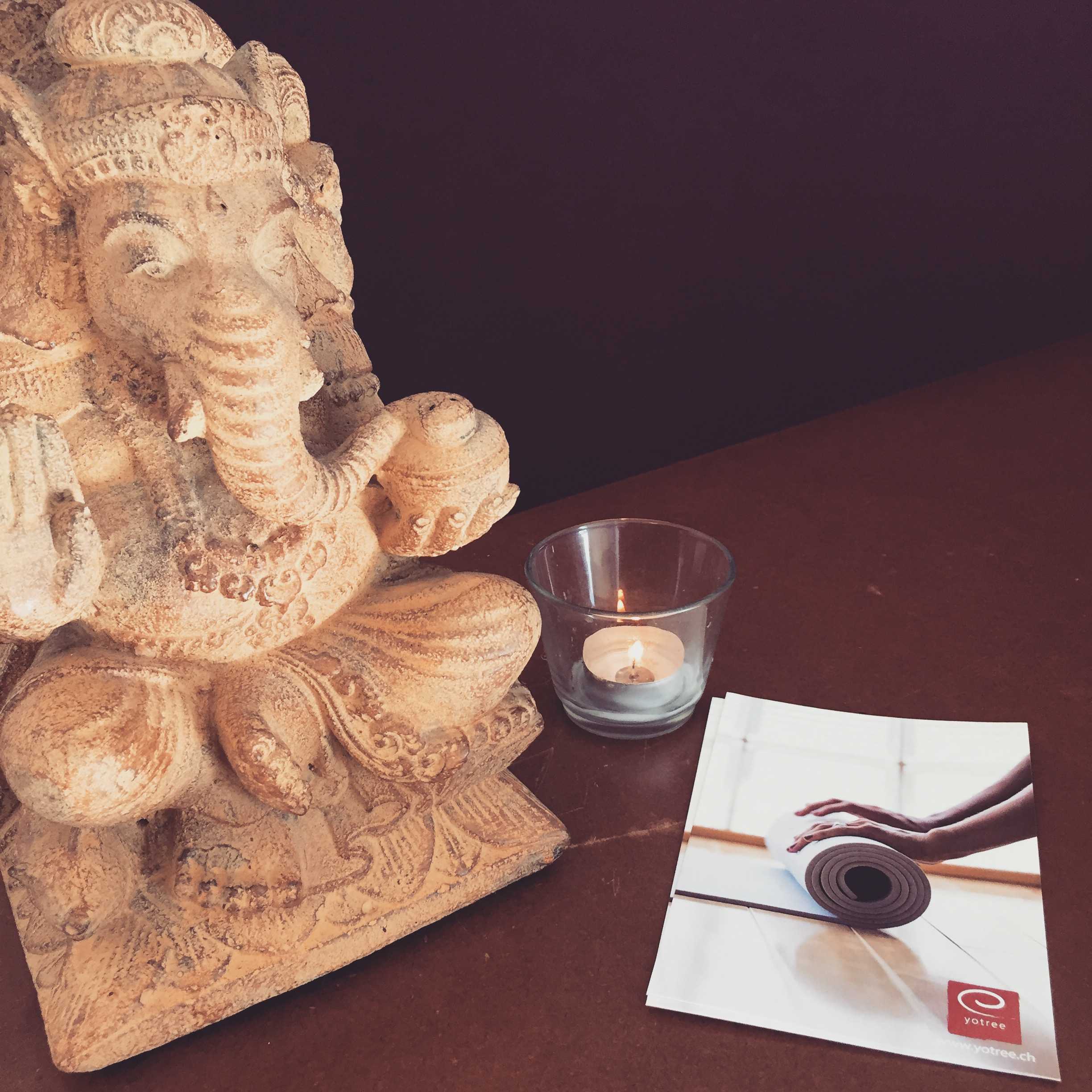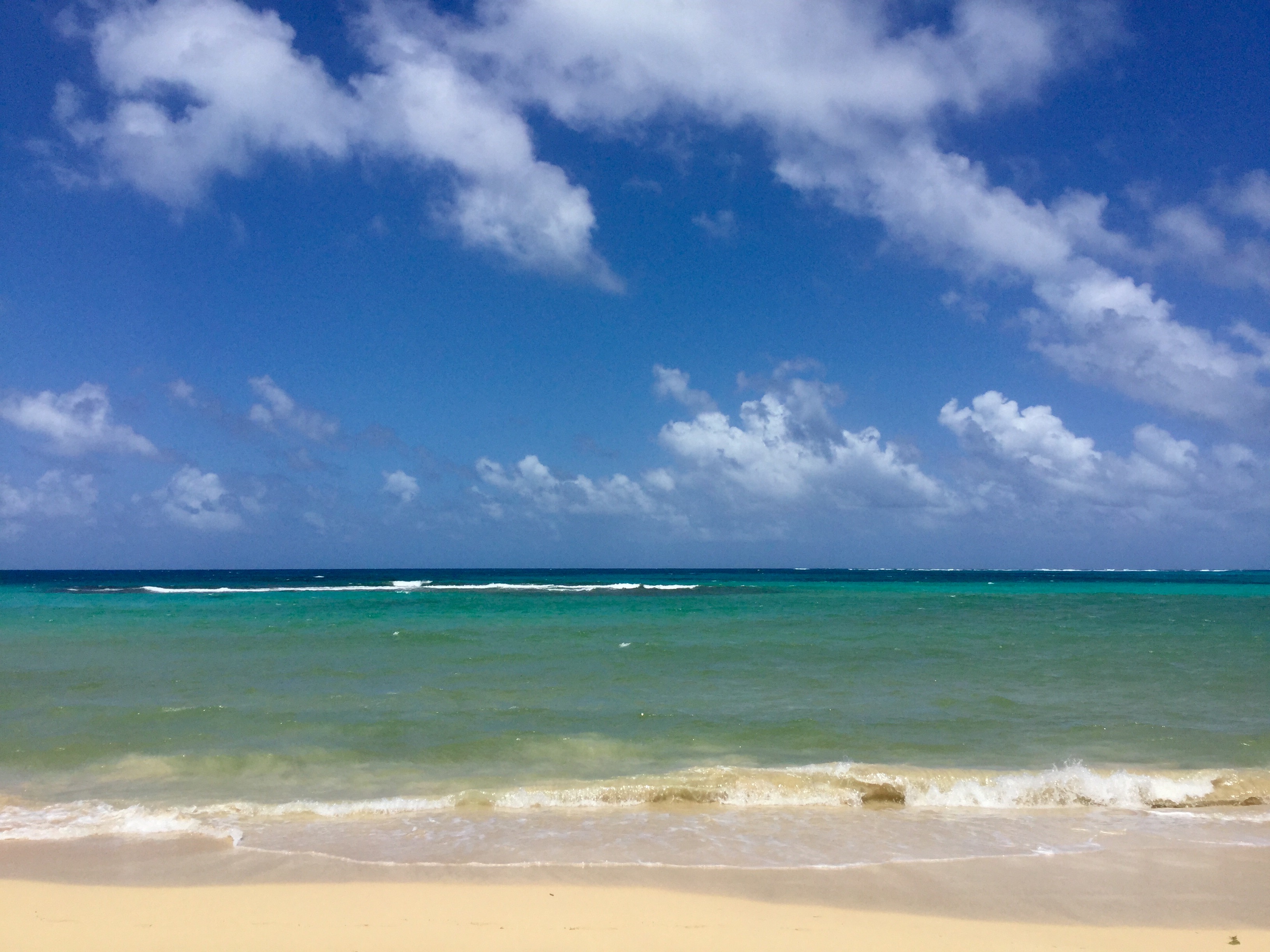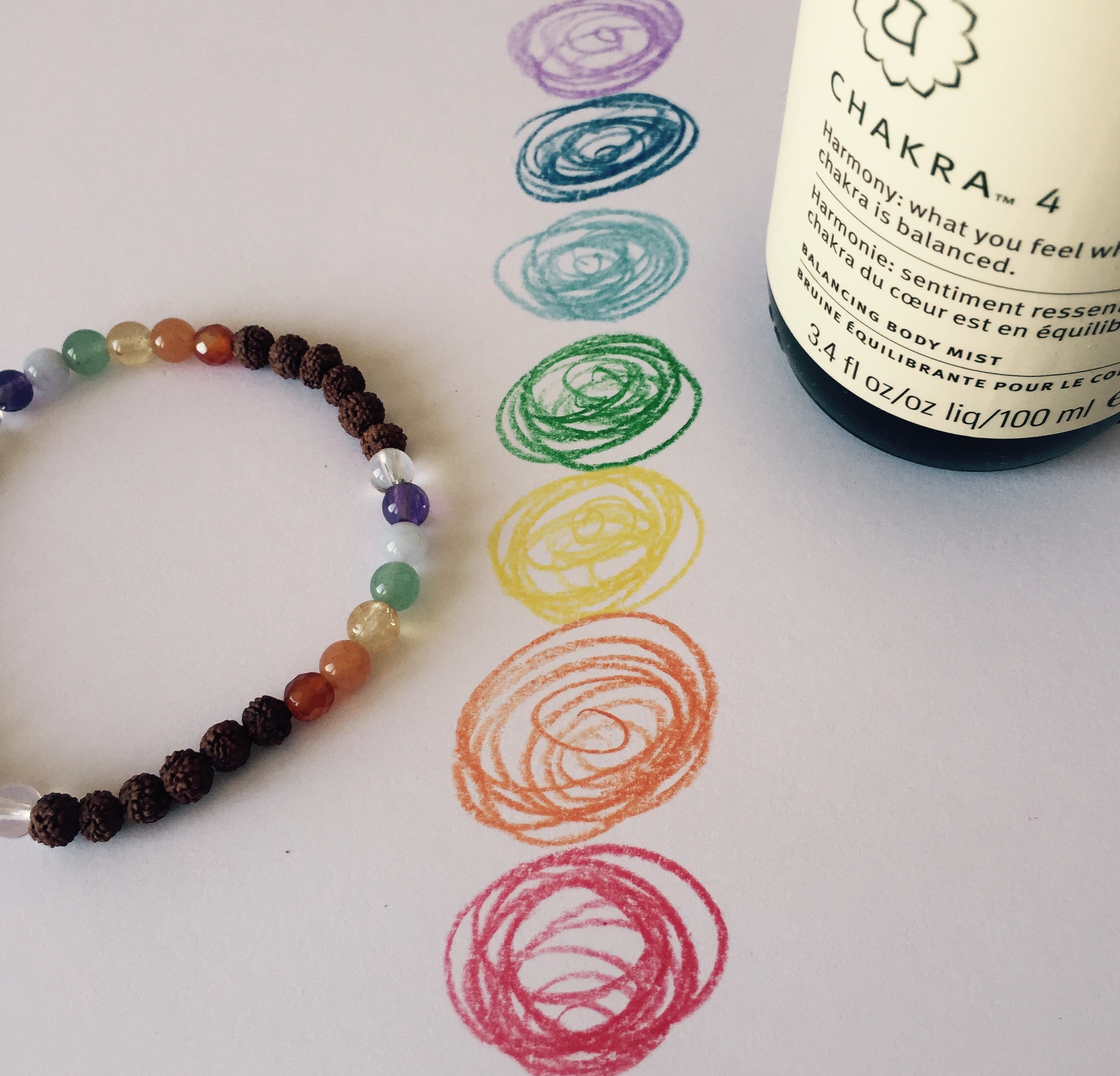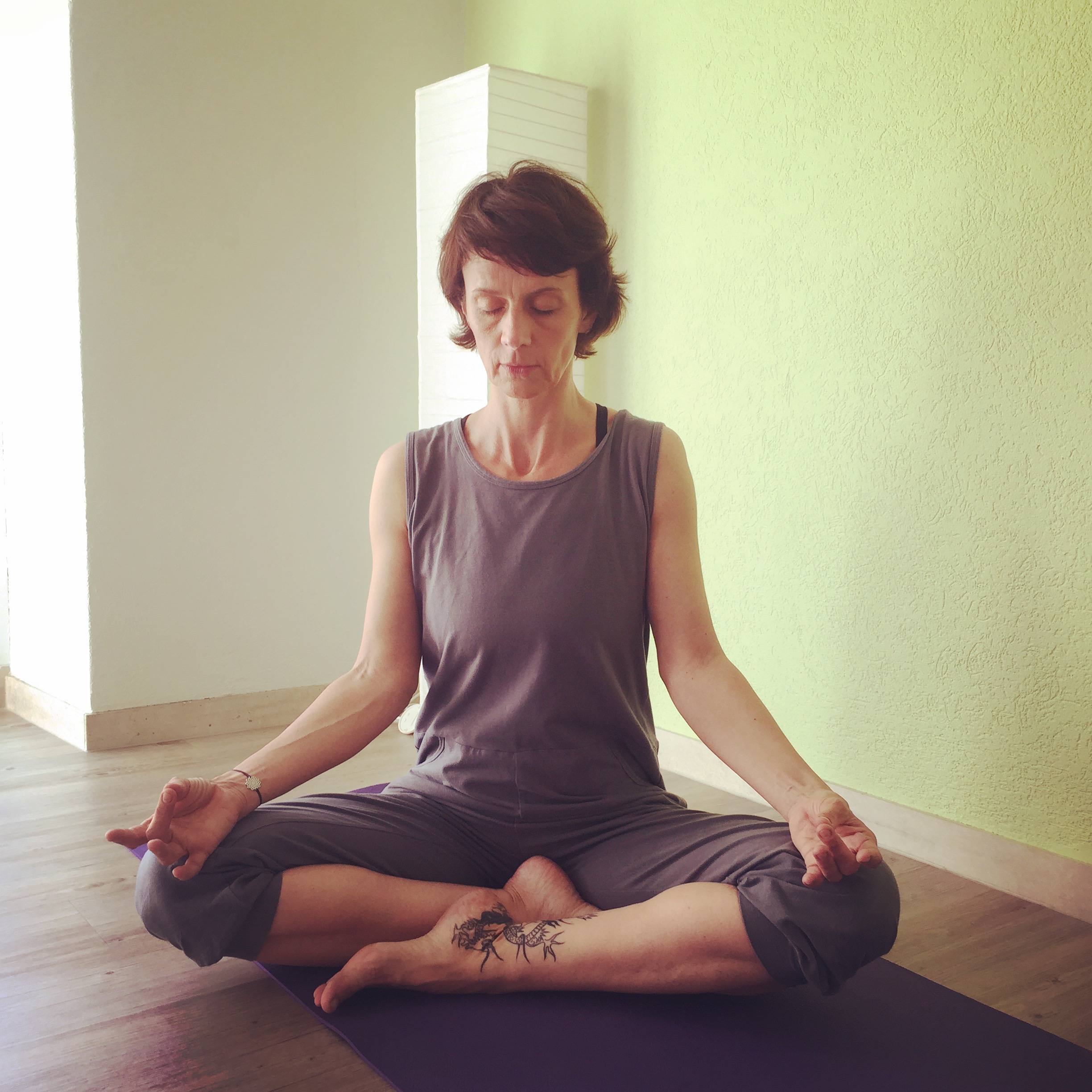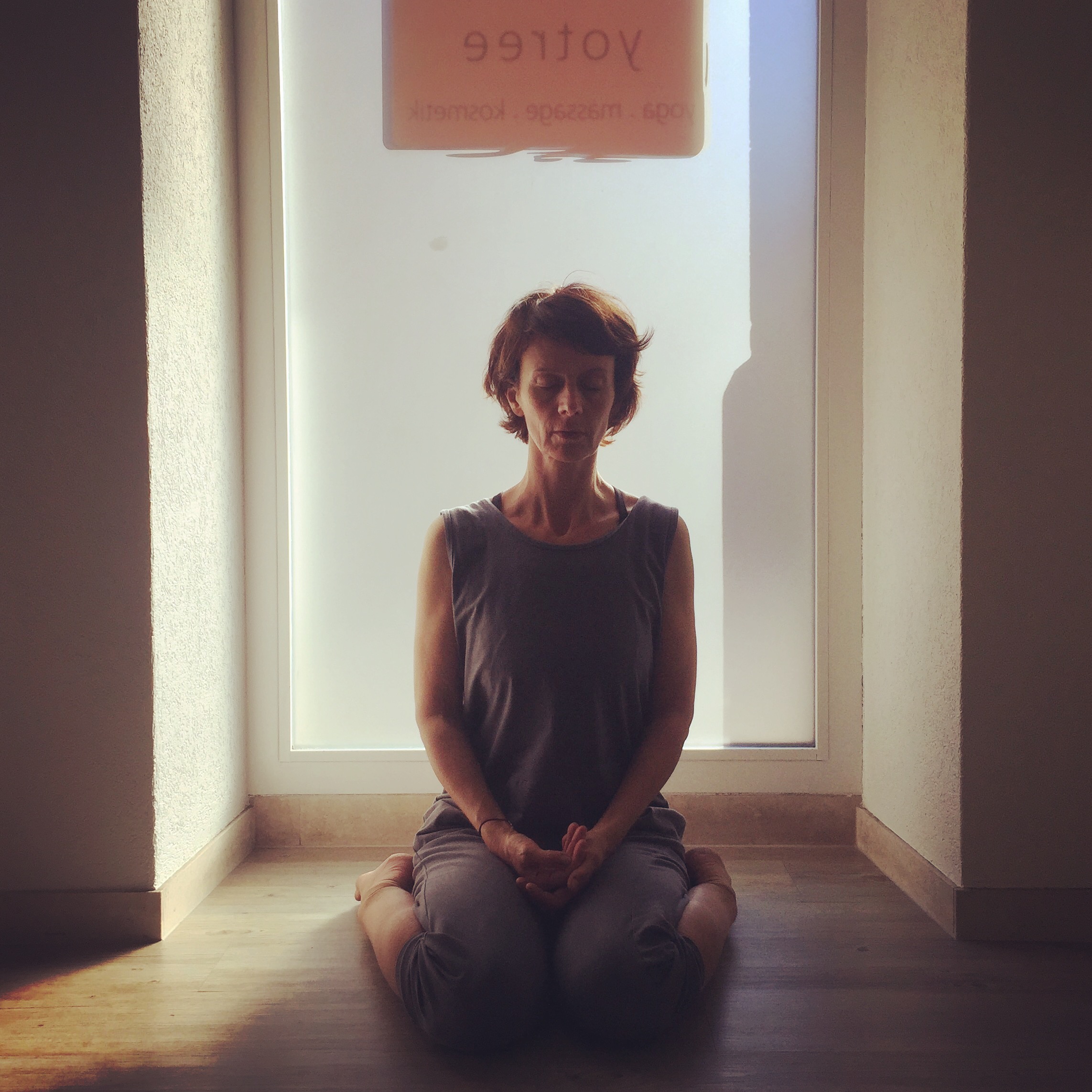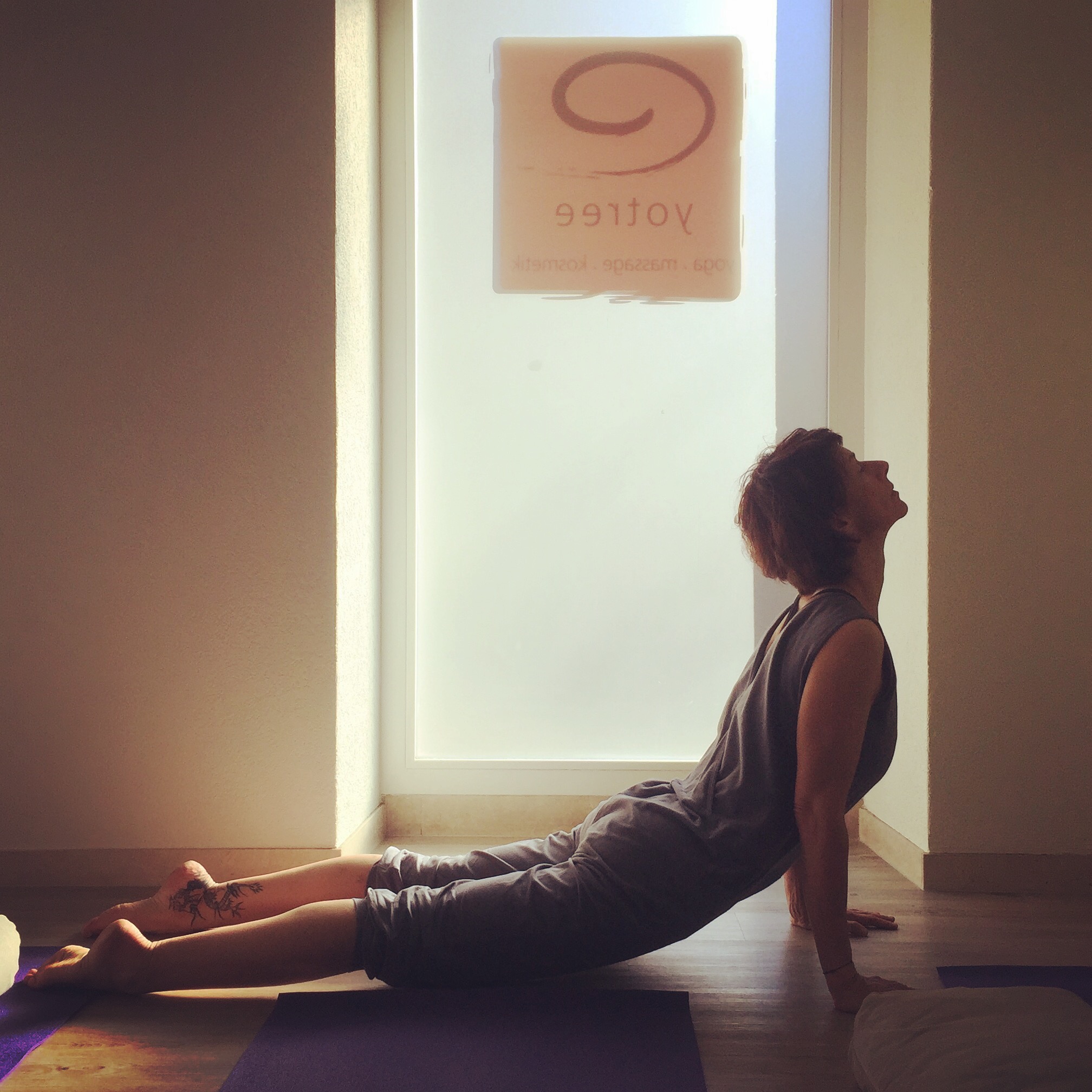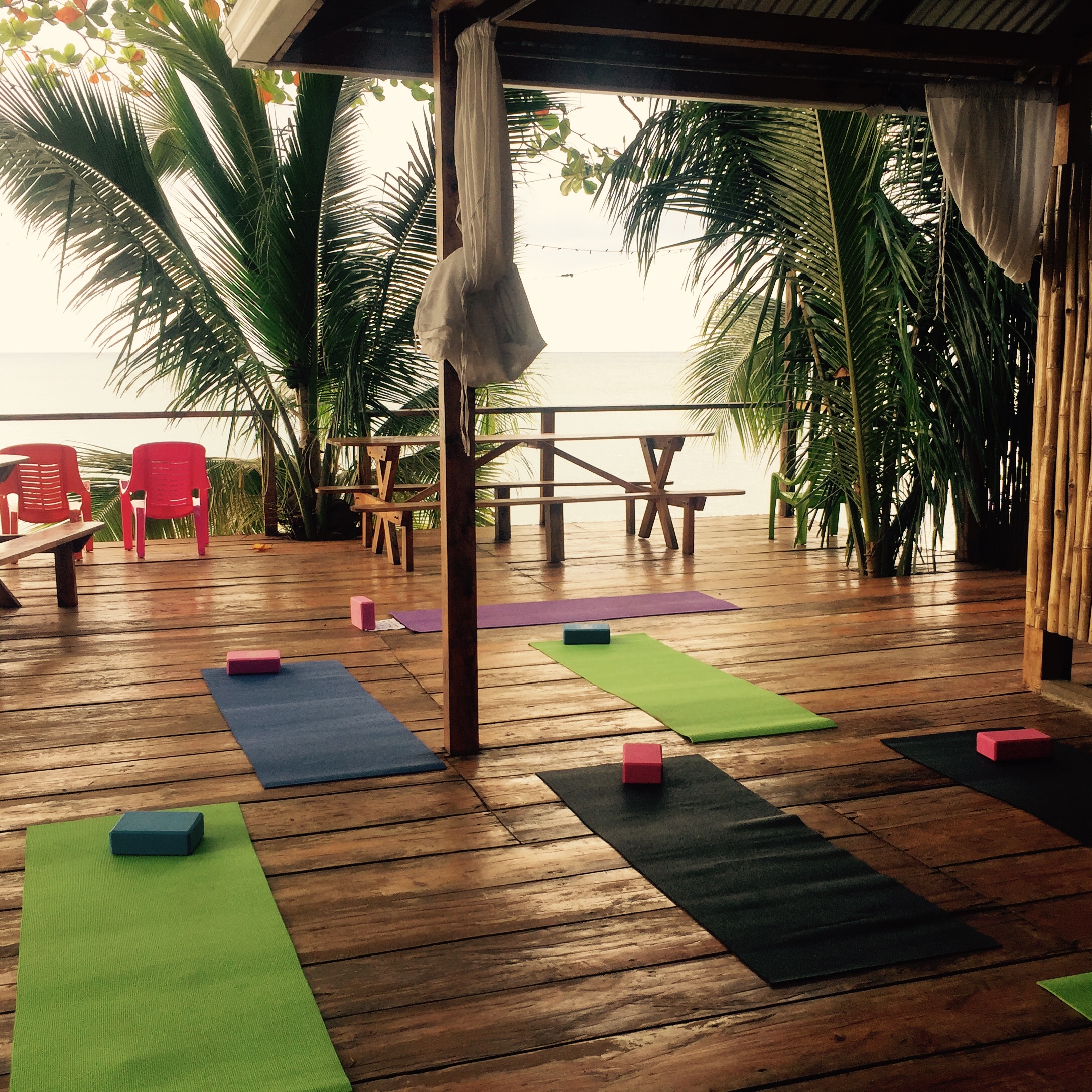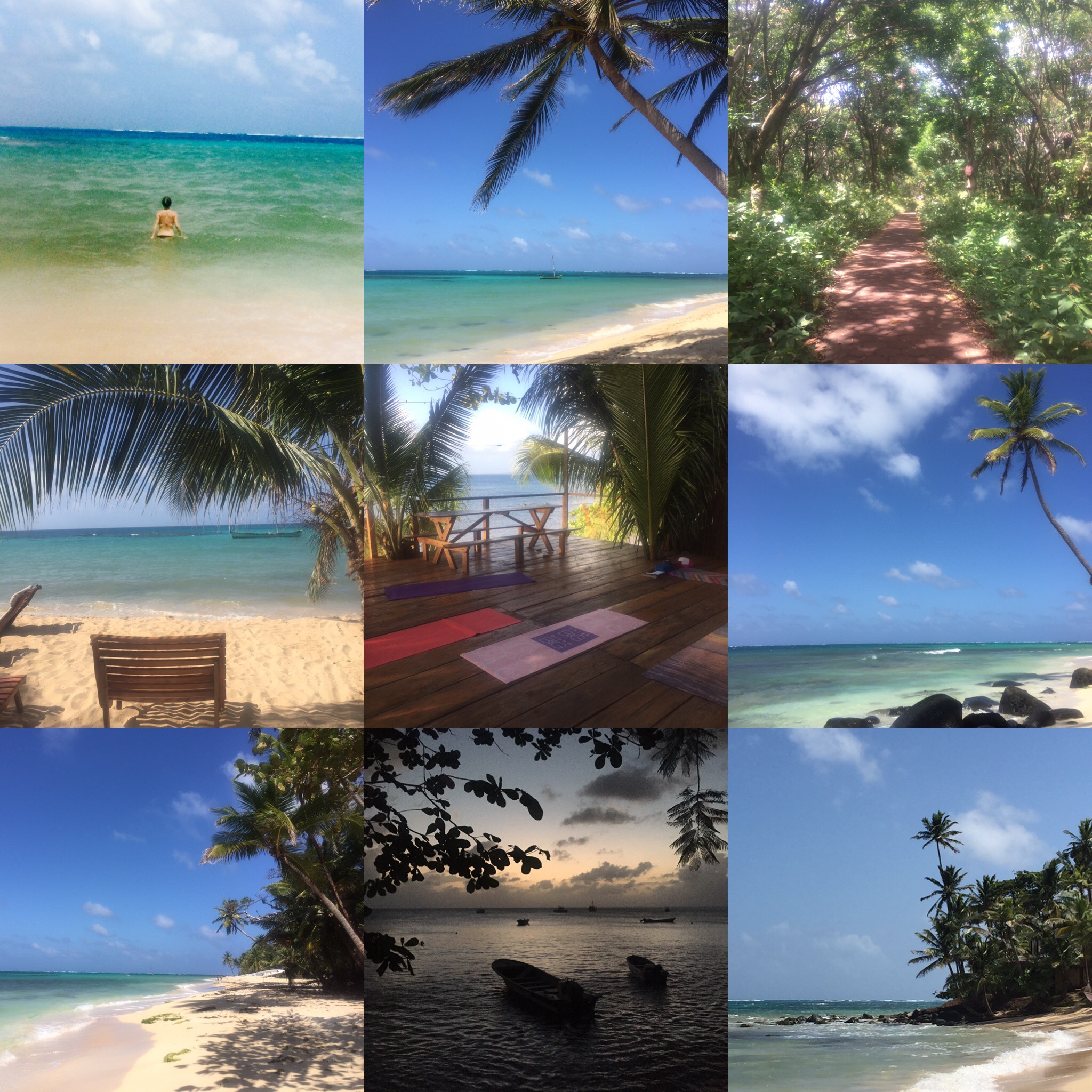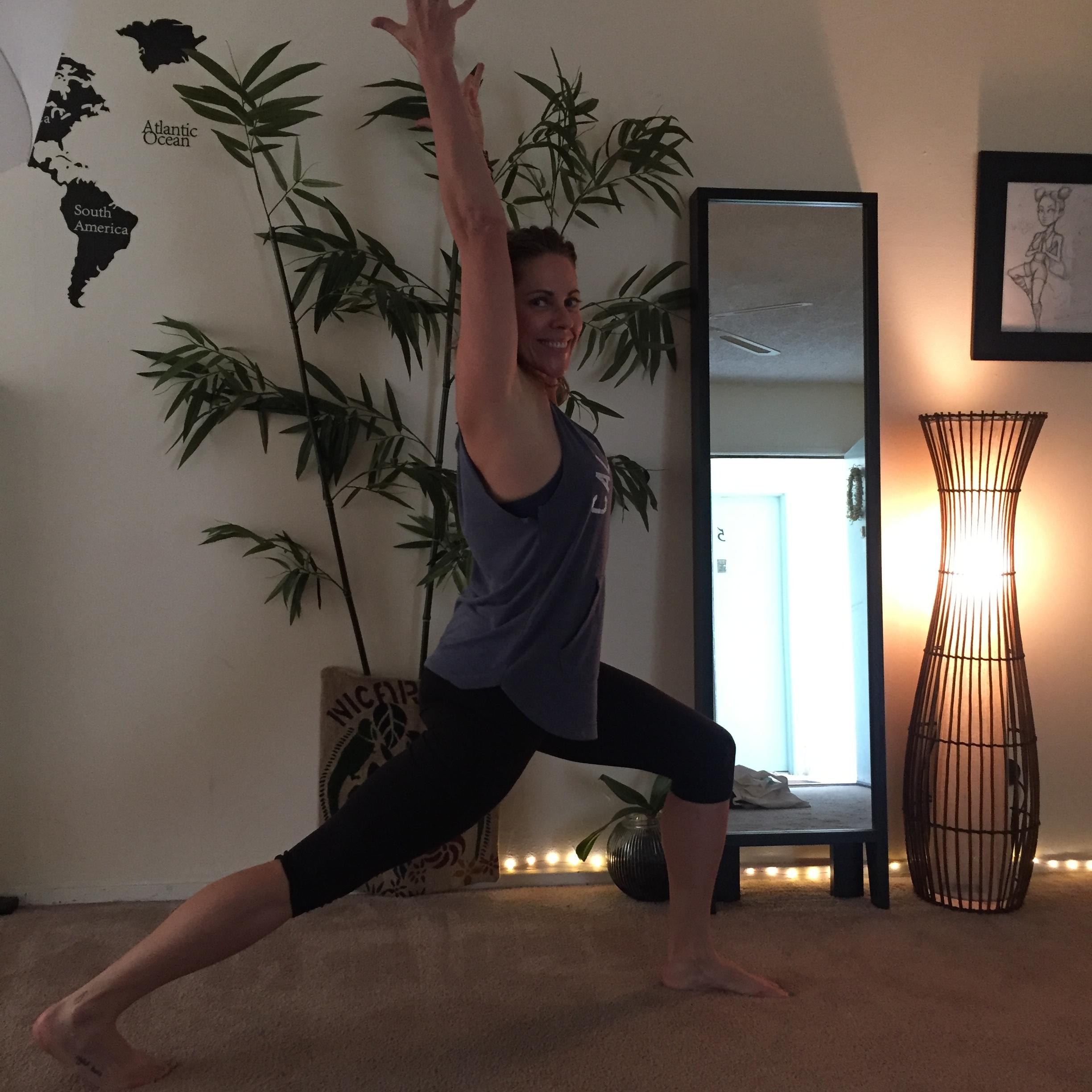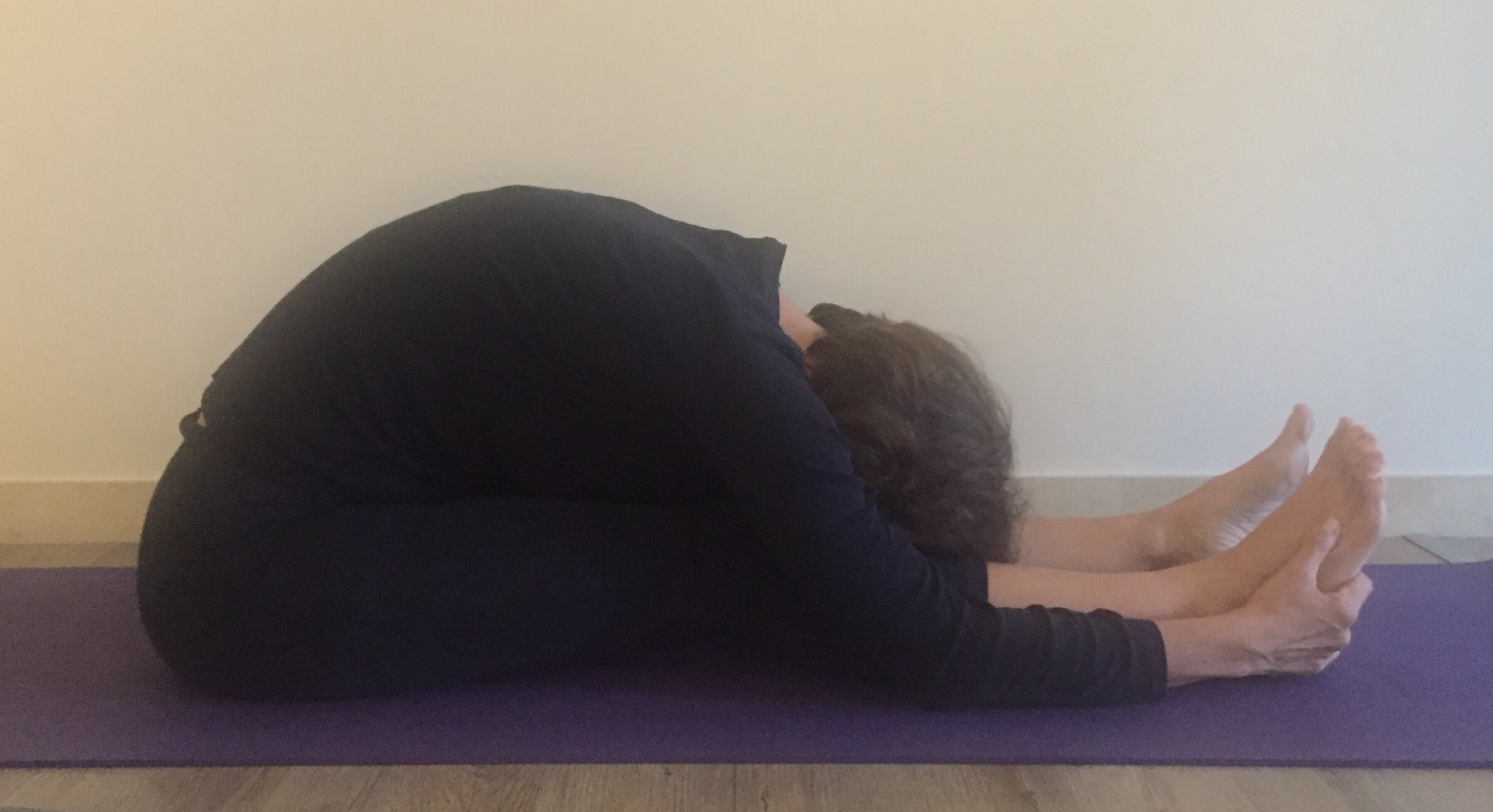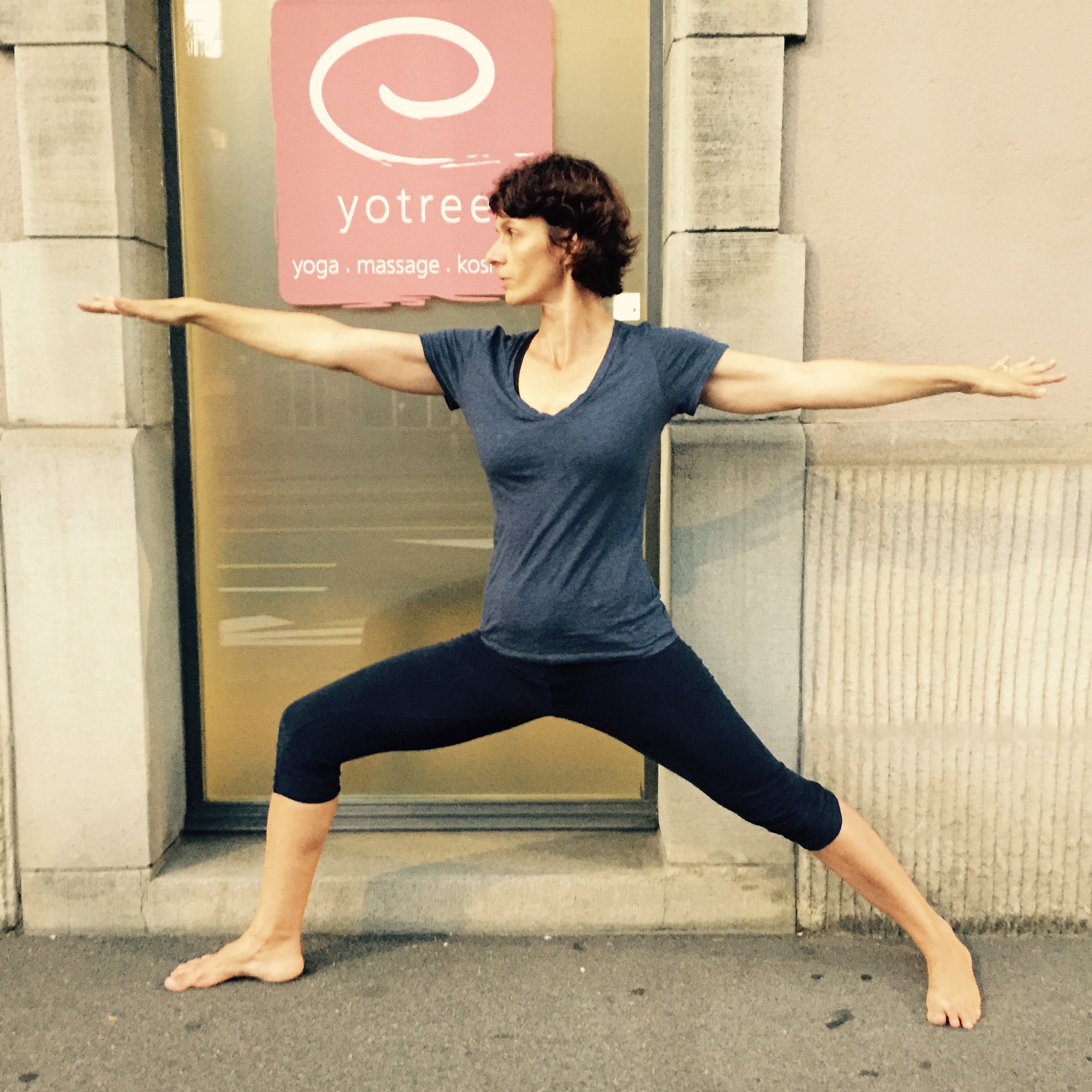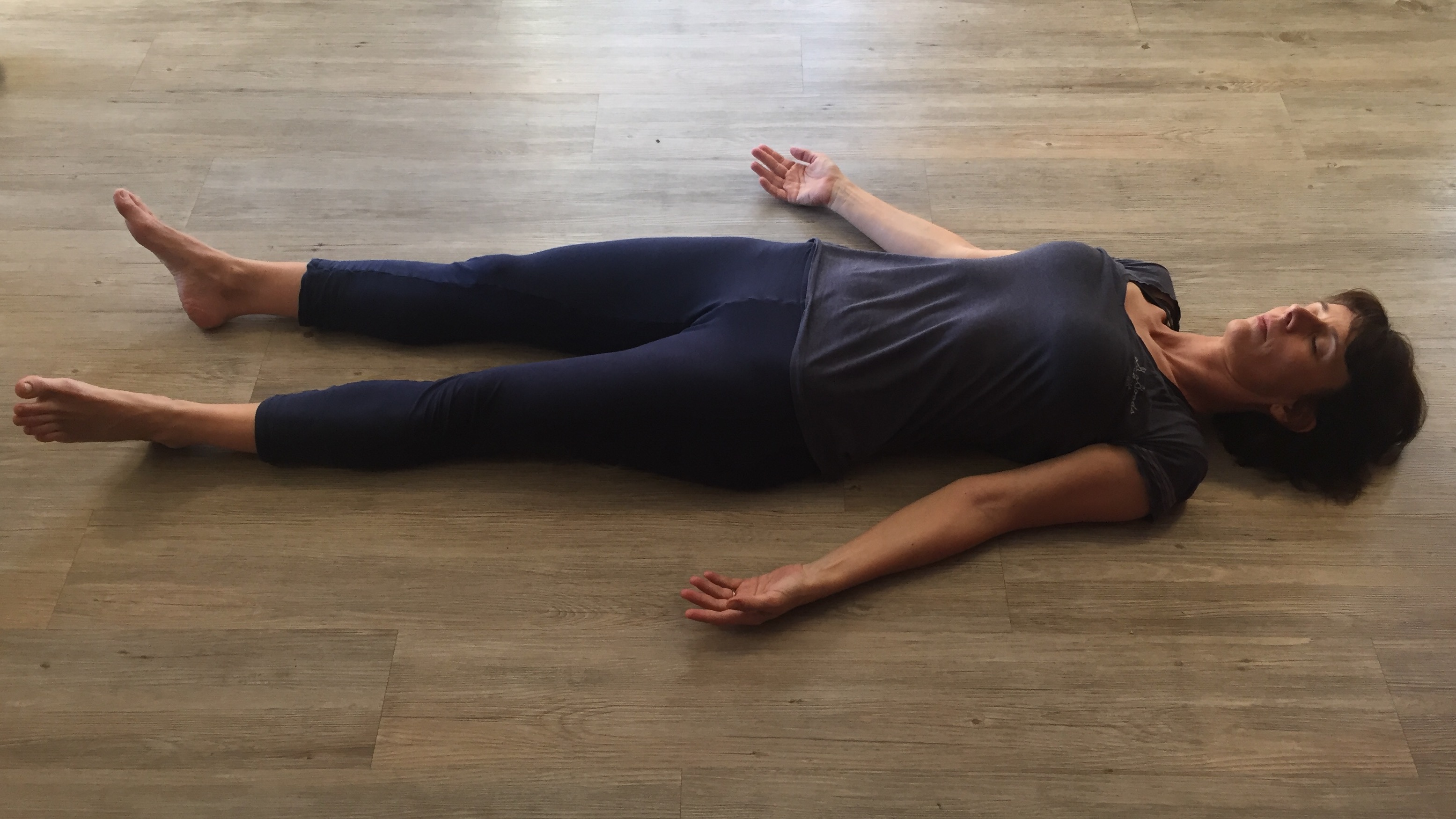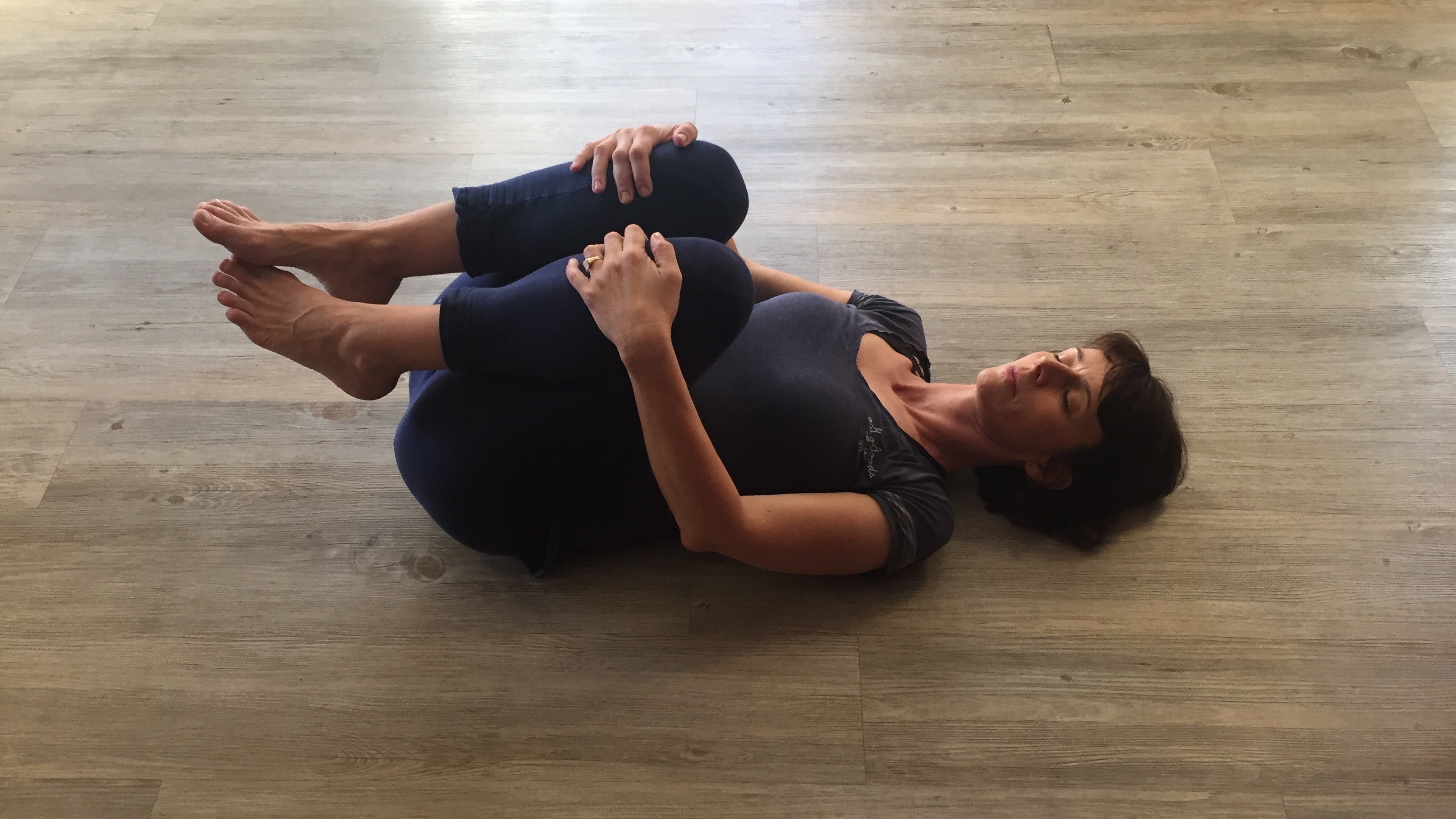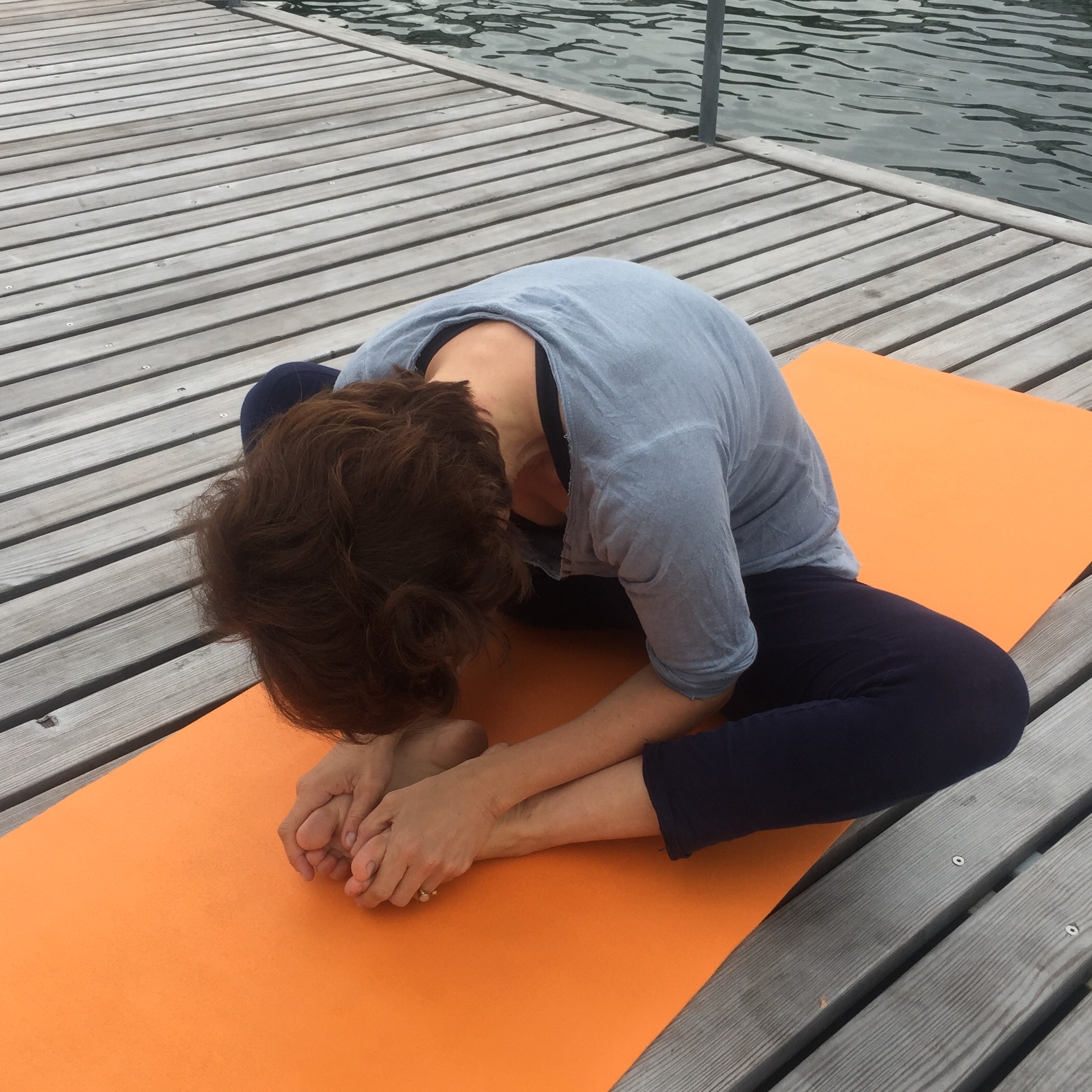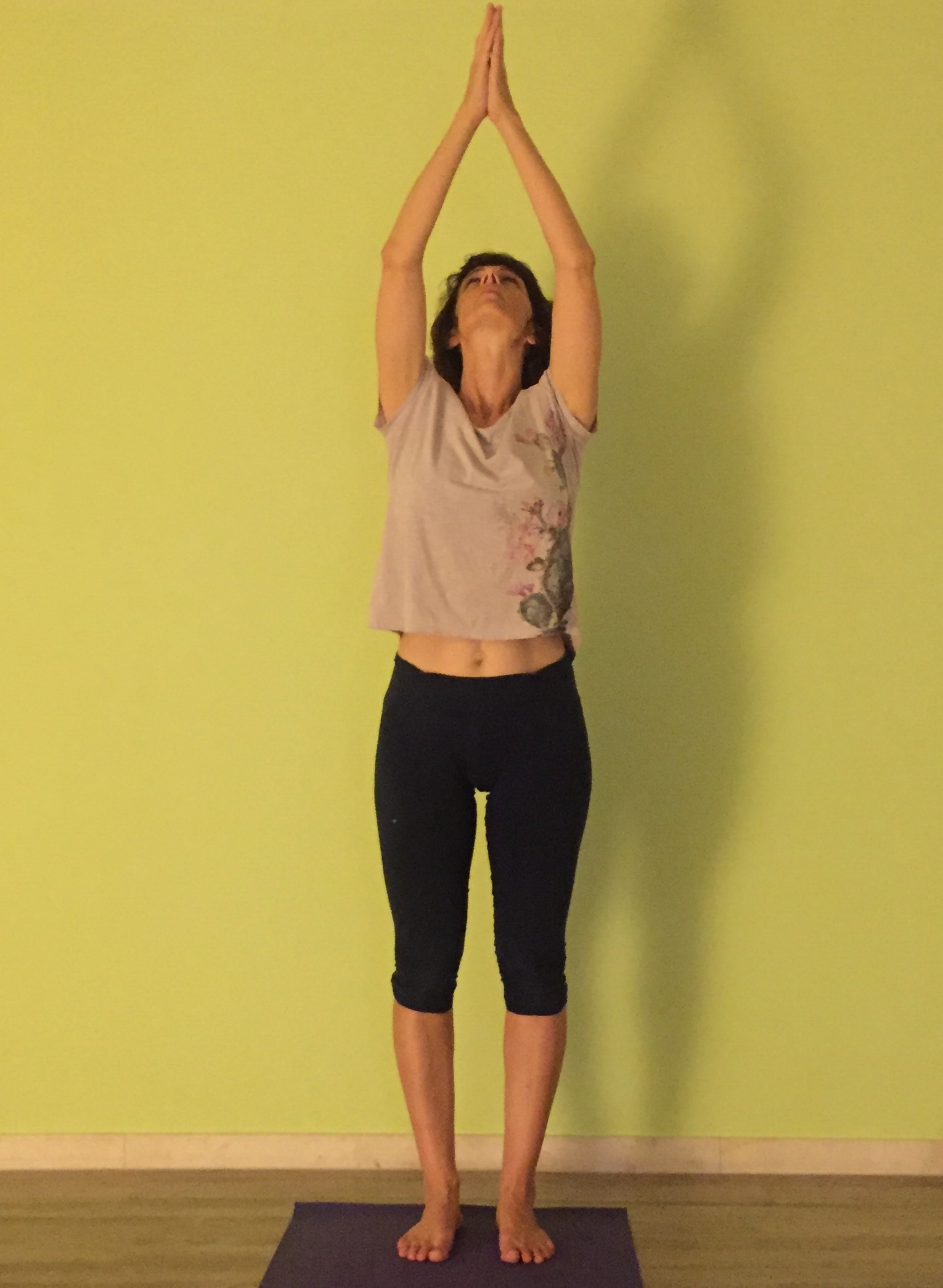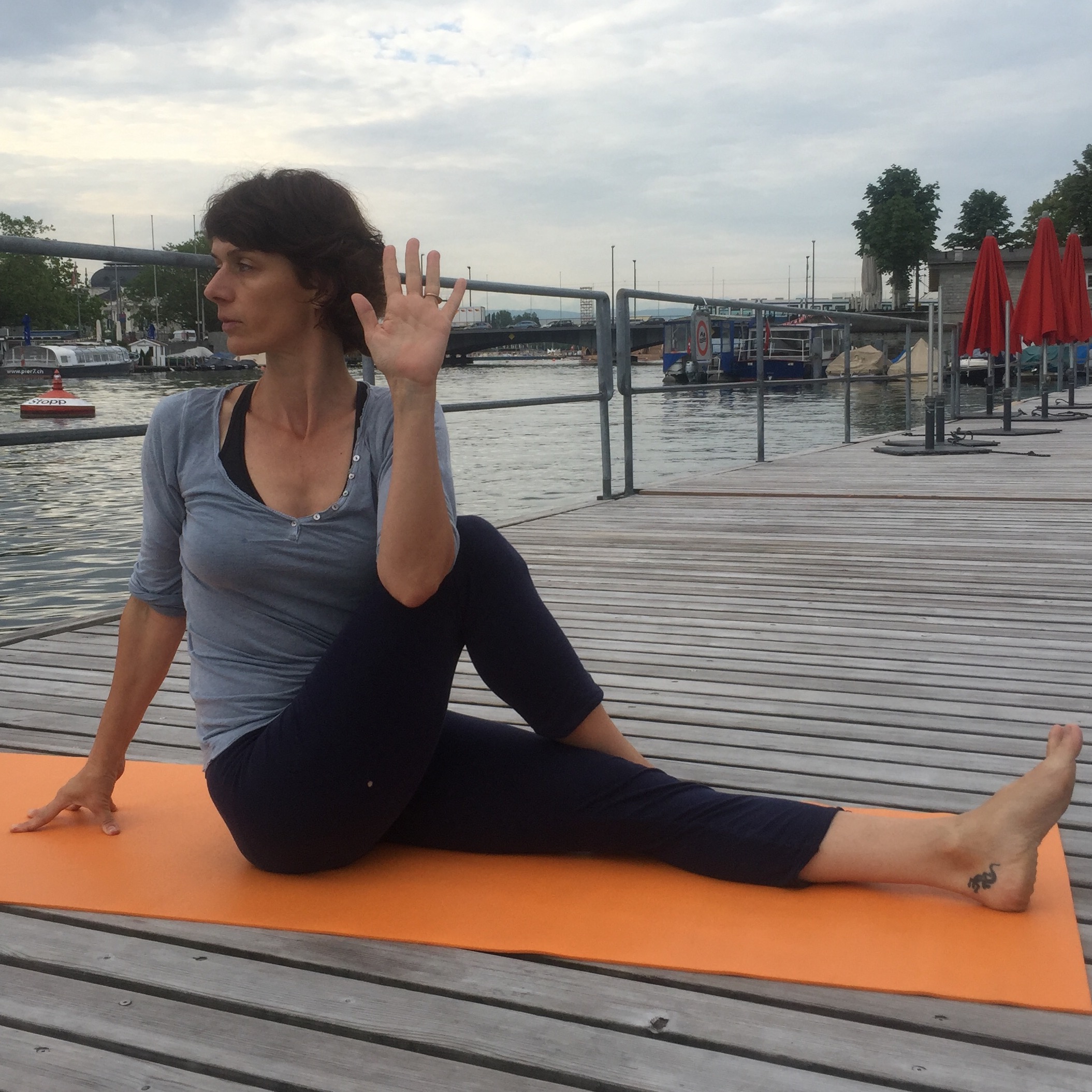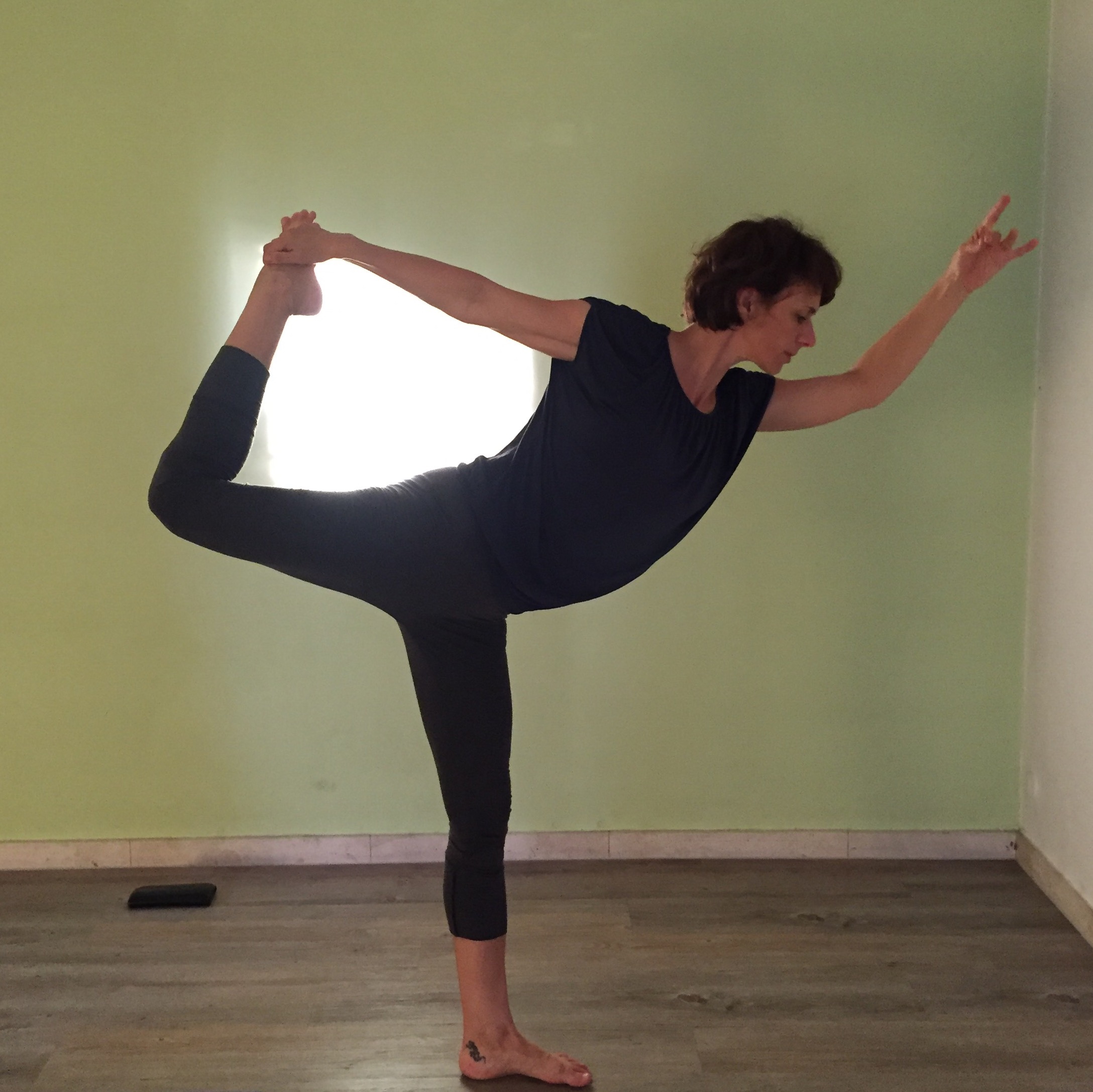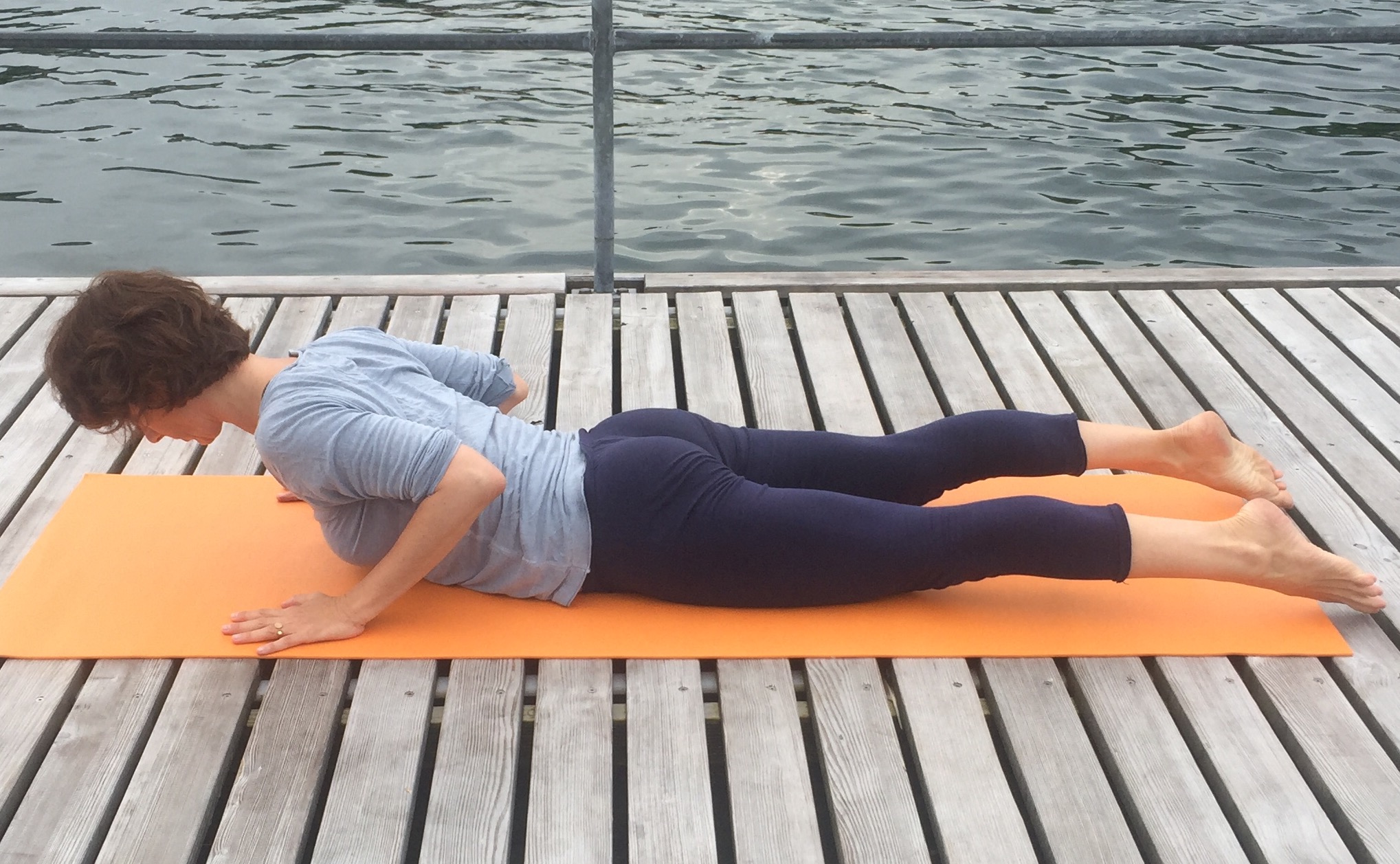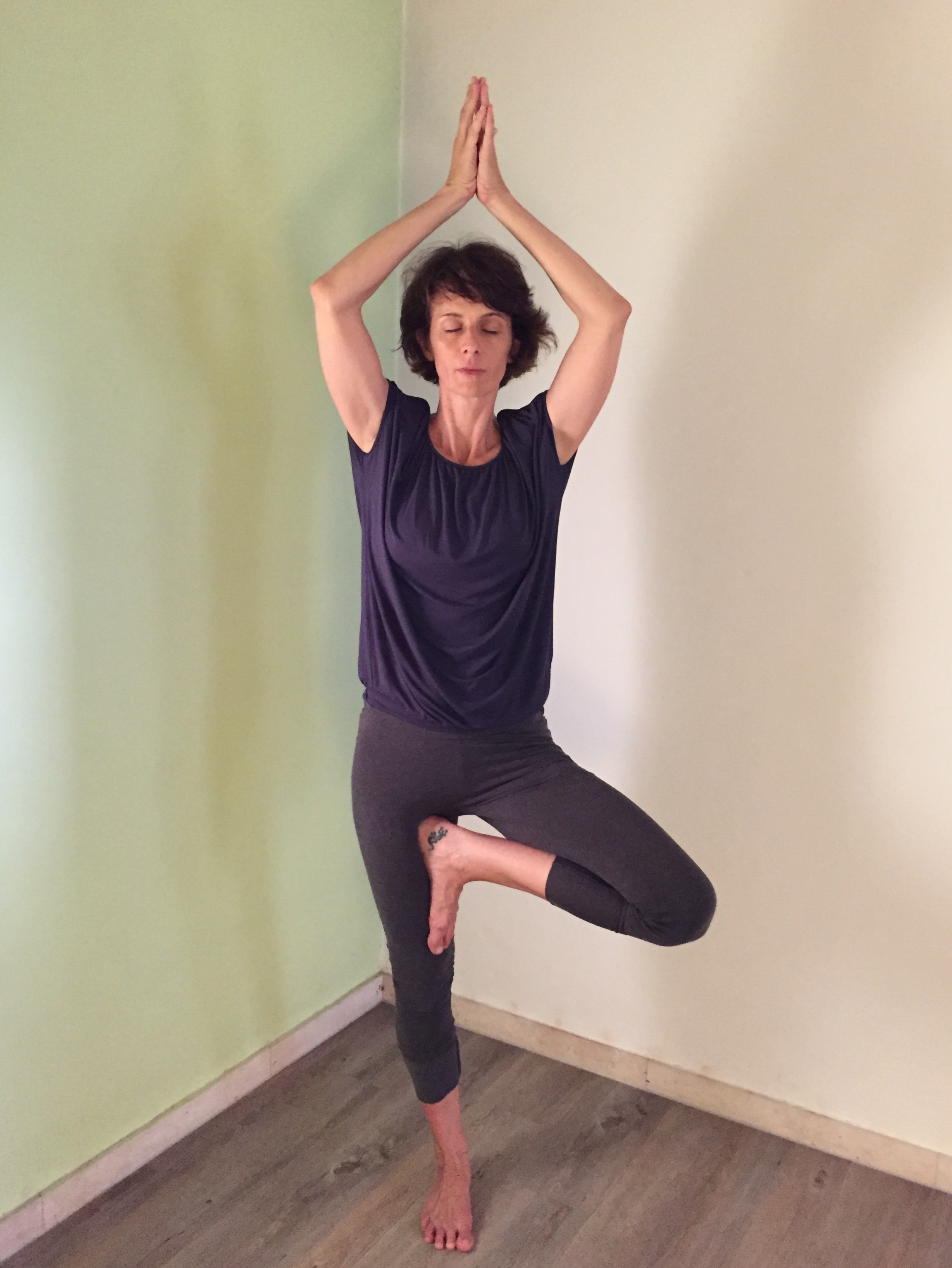why practising yoga is good for us ~ suffer less ~ the five kleshas
Avidya: misperception
Asmita: misidentification
Raga: excessive desire, attachment, craving
Dvesa: Ablehnung, Vermeidung
Abhinivesa: aversion, avoidance, refusal
As long as those mental impurifications are feeding our minds, such as raga and dvesa we cannot feel contentment. The yoga practise helps us to focus on the moment, we live in the present. The focussing on the moment reduces dull and poisonous thoughts that are the cause of our suffering. Not only the mental wellbeing will improve, the physical wellbeing will be enhanced, too
Mudras to let go, get energized and to relax completely
The gesture of letting go is called Ksepana mudra.
Fold your hands, thumbs are intersecting and the index fingers are stretched out, pointing down. This helps to let go mentally and physically (sweat, digestion). After a couple of breaths open your hands, palms facing towards the sky to receive new energy or put your hand into the „new energy mudra“.
Get energized bringing your right hand into a fist. Fold your left hand around this fist. Both thumbs are touching eachother and pointing up. New energy is being channeled through your thumbs into each chakra and you feel an instant energy boost.
The deep relaxation mudra improves your sleep. Close your eyes while practicing this mudra, the sixth chakra gets activated.
Thumbs and index fingers form a circle, both circles are touching eachother at the connection points. All other left and right fingertips are touching eachother slightly.
Recite the mantra So-Ham (I am) and thus enhance the power of this mudra.
Mudras
Mudras are healing hang gestures, that activate our seven chakras and the five elements (thumb = fire, pointing finger = air, middle finger = ether, ring finger = earth, little finger = water). They either have an energetizing or calming down effect. By bringing the hands into a certain mudra the nadis (energy channels) will get full of either energetizing or soothing life energy. The energy can flow freely again and blockades might be eased.
The most famous mudra is the Anjali Mudra. The gesture of gratitude. It is even so famous that it has its own emoticon.
Often this prayer-like handgesture is accompanied by the salute namaste. Anjali means offering. Many yoga classes start and end with this gesture of gratitude.
Place your hands, palms facing eachother in front of your heart, thumbs slightly touching the chest.
Ganesha, the elephant god, half elephant, half human, son of Lord Shiva and Parvati is the most popular deity of the Hindus. He brings luck, and removes obstacles and can conquer border lines.
The Ganesha Mudra brings courage, confidence, openness and faith.
The element fire as well as the heart chakra will get activated and with them life energy and the joy of life. Blockades of the respiratory organs will be eased and the chest gets open again.
At the level of the heart the slightly bent left hand grabs the slightly bent upper right from below. After a few breath cycles change the position of the hands and breathe slowly and deeply in and out again.
Garuda is a mysthic bird, half human, half eagle that posses immense mental strength and an always great overview. Lord Vishnu is riding him. Garuda sees the good in people, in life and he delivers divine orders that will bring clarity in actual life situations.
Place the wrists crossed in front of your heart, palms facing the chest. Both thumbs are hooked into eachother, the other fingers are spread, resembling wings of an eagle.
Eight Limbs of Yoga
As a yogi/yogini one should follow these eight steps to create a happy and purposeful life for oneself and the its comunity.
1 Yamas
2 Niyamas
3 Asanas
4 Pranayama
5 Pratyahara
6 Dharana
7 Dhyana
8 Samadhi
The Yamas are formed of five moral restraints and the Niyamas are five observances, the dos and donts of our lives, ethical precepts and codes, similar to the ten commandments by Moses.
The third limb, the Asanas, the physical practice is maybe the mostly known limb of the eight limbs of yoga. The postures, poses improve strength, flexibility and balance and enhance our ability to concentrate. The aim of asana practice is to find physical (and mental) stillness, to prepare the body (and mind) for meditation.
Pranayama consists of mindful breathing exercices, to fill our bodies with prana, life energy. Pranayama helps to calm our mind and to prepare the mental body (read the article about the five koshas below) for meditation.
Pratyahara is the withdrawing of the senses from the outside world and thus the turning inward, looking within. The mind focusses on a single thing at the time, for example focussing on the breath, doing a bodyscan or Yoga Nidra are wellknown forms of practicing Pratyahara.
Dharana signifies concentration and is a result of Pratyahara. The focus of attention is held in one direction as for example in a Japa Meditation (or praying a rosary).
Meditation as observation and reflection or contemplation is called Dhyana. Dhyana is the fruit of the meditative practice of Dharana.
Finally the eighth limb is pure bliss. The merging of the self with the object of meditation is called Samadhi. In other cultural contexts and religious backgrounds the words Enlightment, Nirvana, Heaven, Paradise, ZEN etc. describe the same concept.
Love & Light!
Why practising yoga is good for us ~ become enlightened ~ the five koshas
1st layer, the physical body (gross body)
Body (Anamaya)
shape, skin, pulse, physical, food
2nd layer, the energy body (suptle body)
Breath (Pranamaya)
Life force, energy, vital
3rd layer, the emotional body (suptle body)
Mind (Manomaya)
Thoughts, emotions, mental, loud voice
4th layer, the wisdom body (suptle body)
Inner voice (Vijnanamaya)
Quiet, inner wisdom, intellectual
5th layer , the bliss body (causal body)
Joy (Anandamaya)
Quiet, peaceful, no suffering, blissful
Pure light, soul, SELF
With yoga we want to find this pure light. We do not want to be stuck in the outher layers, we want to find peace and happyness. The journey to this pure light, the SELF is connected with a yogic lifestyle. The journey inward. We are the light. The union with this light, the divine, the divine in ourselves is called YOGA. Om mani padme hum, namaste and enjoy the yoga bliss!
The Seven Chakras ~ Energy Meditation
Muladhara root chakra
red ~ I am grounded ~ LAAM
Svadhistana sacral chakra
orange ~ I am nourished ~ VAAM
Manipura solarplexus chakra
yellow ~ I feel the intention ~ RAAM
Anahata heart chakra
green or rose ~ I feel the harmony ~ YAAM
Vishudda throat chakra
turquoise ~ I am expressive ~ HAAM
Ajna third eye chakra
deep purple ~ I am insightful ~ SHAAM
Sahaswara crown chakra
white or ultra-violet ~ I feel enlightment ~ OM
Sukhasana (easy pose)
Today here in Berlin at Spirit Yoga I opened and finished my asana practice in Sukhasana, the easy pose.
As with both asanas (Virasana and Vajrasana) discussed in my last blog post, Sukhasana, too is a great way to become still, quiet and meditative. Sukha in Sanscrit means easy, comfortable and light whereas sthira means stable, strong, powerful. Sthira-Sukham Asanam (Patanjali Yoga Sutra 2.46) stipulates both aspects of the basis of an asana: sthira and sukha, both are needed for a balanced/ right pose for meditation. Sukhasana is therefore easy to practice as the name already suggests. Sukhasana stimulates all seven chakras, but it is especially helpful in easing blockades of the third, the manipura, chakra and hence good for the "middle" or inner balance.
Sit firm with both sitting bones on your mat, cross-legged, spine straight. Relax your mind, let your thoughts go and set yourSELF free. Place your hands on your thighs, your knees, in your lap or bring them in Anjali mudra to your heart. Intentions, that are rooted in your manipura chakra can now be set and turned into an affirmation or mantra. Om mani padme hum. Namaste!
Vajrasana (Thunderbolt Pose) and Virasana (Hero Pose)
Toes, feet and ankles get strengthened and stretched. A blanket below the knees or a block between the feet help to sit comfortably in Vajrasana. Advanced yogis can meditate in Virasana, hero pose as demonstrated by Barbara, where you do not sit on, but between your heels. The hero pose further stretches your quads and hammies.
You can put your hands into your lap, palms facing down to get grounded or up to receive energy. You can even form a mudra (symbolical hand gesture, more about mudras as of July here on this webpage) if it suits your intention. Namaste.
June 6
Ardha Purvottanasana (Table Top)
Sit on your mat and place the feet hip-wide apart in front of you, put the hands, fingers facing towards your rear, behind you. Engage your core and push your pelvis up.
Make sure your shoulders are placed above your wrist and your knees above your ankles in order to get a straight line from knees to shoulders. Your chin can either be reaching towards the collar bone or if you have strong neck muscles, tilt it back and focus the sky as Barbara of Yotree Yoga Studio is demonstrating.
Purvottanasana is the reversed plank pose. The arms will have to be placed in the same position as in Ardha Purvottanasana, but your legs will be stretched out completely. This is a pose for more advanced students as it requires strong wrists and a strong lumbar. Ardha Purvottanasana is easier to perform and therefore also suitable for yogis with disc issues. Live your intention and feel the power from within. Namaste!
Urdhva Mukha Svanasana (Up Dog)
The super intense stretch of the lower back strengthens the back muscles as well as the spine and improves its flexibility. The abdominal organs and the thyroid gland get stimulated. It soothes the nervous system and is ideal for people that are sitting on a chair a lot. But whoever is facing lower back issues should avoid this pose, a baby cobra features similar benefits as the up dog and is less strenous on the lumbar. The third (solarplexus), fourth (heart) and fifth (throat) chakra will get activated and energized.
The elbows have to be placed just below the shoulders as you are lying on your stomach. Engage your core and pull your navel towards your spine. Push your upper body up and back. Bend it slighlty. Tilt your head back and look up. Curl your toes under or put the top of your toes on the mat (this allows a deeper stretch). Barbara demonstrates both versions of the up dog in the Yotree Yoga Studio. Namaste.
I am a RYT 200 now!
Yoga Teacher Training, Little Corn Island, Nicaragua
February 1
Trikonasana (Triangle)

This pose enables you to stretch your legs, arms, flanks and your spine. The flexibility of your spine and your hips will improve and the grounding feeling will get increase as you are standing strong on your mat. This pose is especially helpful when you face blockades of the third chakra, the Solarplexus. Problems with the digestion will be eased and your body feels lighter again.
Stand with your feet far apart from each other, about a leg-length, in order to get this triangle shape. Then bend your upper body towards the left or right side and spread your arms out. Look up to the fingertips of your upper hand. Namaste.
January 24
Setu Bandha Sarvangasana (bridge)
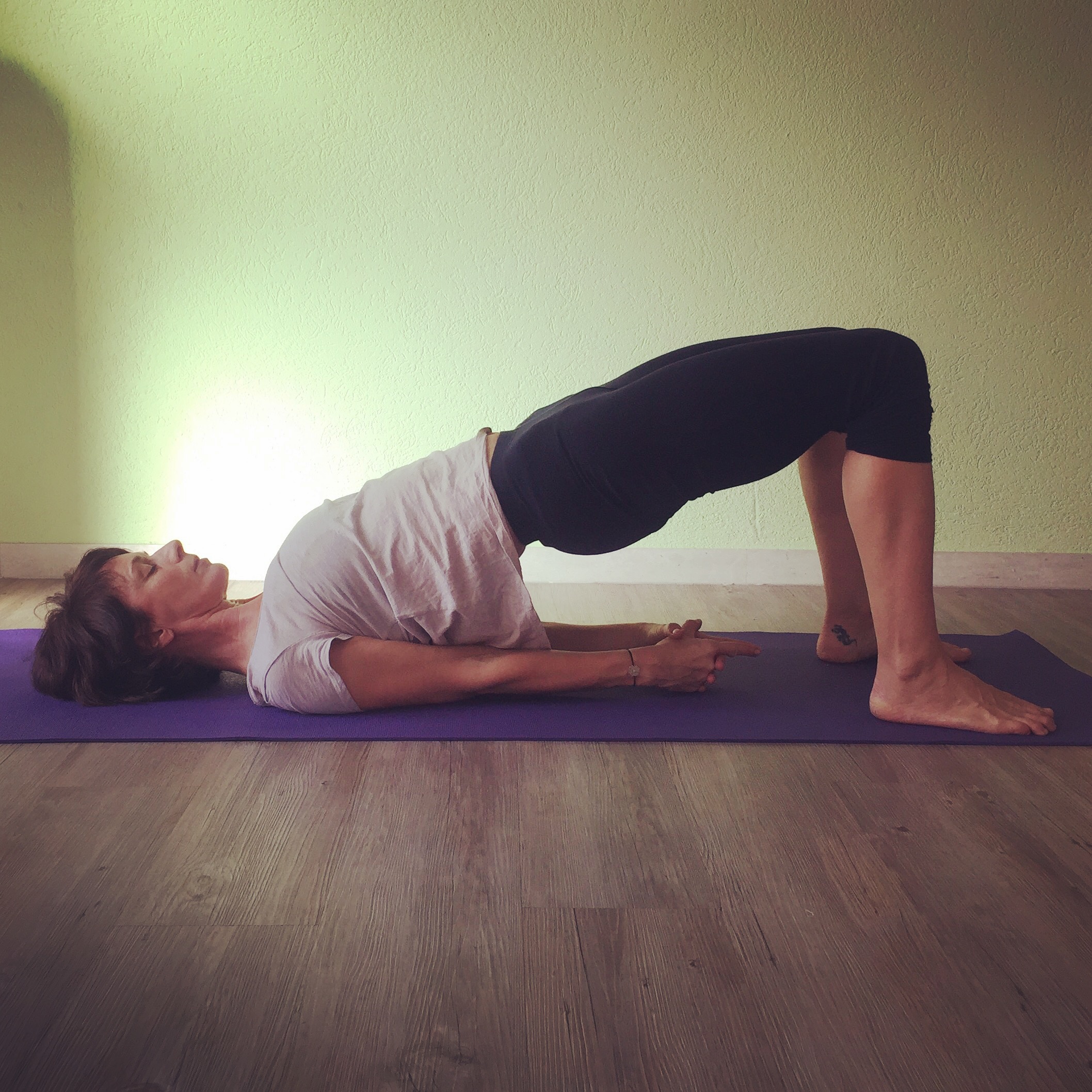
The bridge pose calms the mind and especially the back and heart benefit from practicing this pose. The upper torso gets a gentle stretch, the legs, hips and pelvis will be trained and strengthened while the shoulders and chest will be opened. The blood circulation and the digestion will improve, stress and anxiety levels minimized. The pose stimulates the first chakra (root chakra) as you feel grounded and connected by pressing the feet in your mat, the fourth chakra (heart chakra) as your compassion level will raise and your fifth chakra (throat chakra) by helping you express yourself and communicate better.
As Barbara shows nicely on this picture, the full body weight lies on her shoulders and feet. The pelvis will be pushed upwards thus the upper body hovers. The hands can be placed folded under the back or besides the flanks. The neck lies relaxed on the mat. Enjoy the inner calm and namaste.
January 17
Halasana (plow)
The plow pose, as this folded inversion is called in English, stretches the spine, back and legs and improves the blood supply of the heart. The inner organs get a gentle squeeze and thus will be massaged. As this pose helps you to enter the state of harmony of body and mind which then leads to more clarity and serenity, it is considered a perfect pose to prepare yourSELF for relaxation and meditation. Depending on the literature you consult, it activates the root, the heart and throat chakras.
As you lie down on your back, you bend your legs and bring them towards your chest. Now tilt your hips and place your hands on your lower back for support. Your arms may rest there now for the entire time or they are positioned along your body, palms down for grounding purposes, palms up to connect with the universe or folded, whatever suits best your intention. Bring your legs first above the head, like as if you are practicing a shoulder stand (weight lies on shoulders not on neck) and then place the toes behind it. You can straighten your legs or bend them, as Barbara of Yotree is doing, depending on what is easier and more comfortable for deep and relaxed breaths. Namaste.
January 10, 2017
Shalabhasana (Locust pose)
The physical benefits of the locust pose is the deep stretch of your spine, the strengthening of your abdominal, leg and back muscles (especially the lower back muscles and therefore your backpain will soon be history...)
As with this backbend your chest gets a massive opening, your breath can flow easily and free again, thus your ability to concentrate and self-assertion will improve.
As you lie flat on your stomach, you place your arms and hands either under or next to your hips (as shown by my yoga teacher Barbara of Yotree in Zurich). Alternatively you can roll your shoulders lightly inwards and then stretch your arms along your flanks. Lift your head, legs and pelvis and remain in this pose for some breaths. Namaste!
December 18, 2016
Navasana (Boat)

The boat pose is excellent for activating the energies of the first chakra. A sense of basic trust and feeling grounded are positive side effects of a healthy, active and free root chakra. The pose strengthens the lateral abdominal muscles and therefore it is a very good pose to activate the third chakra, the solarplexus, too.
The spine and the abdomen will be strengthened and the digestive organs stimulated. The pose is said to help reduce stress as the breath can flow free again.
Self-confidence and inner balance will be supported, willpower and courage generated.
Lift your upper body (if in shavasana) and legs (if in a sitting pose). Stretch out your arms and hands towards your knees or on the side or fold your hands in front of your heart as Barbara of Yotree is doing. The lower legs can be bent to get more balanced. Namaste.
December 11
Dhanurasana (Bow)
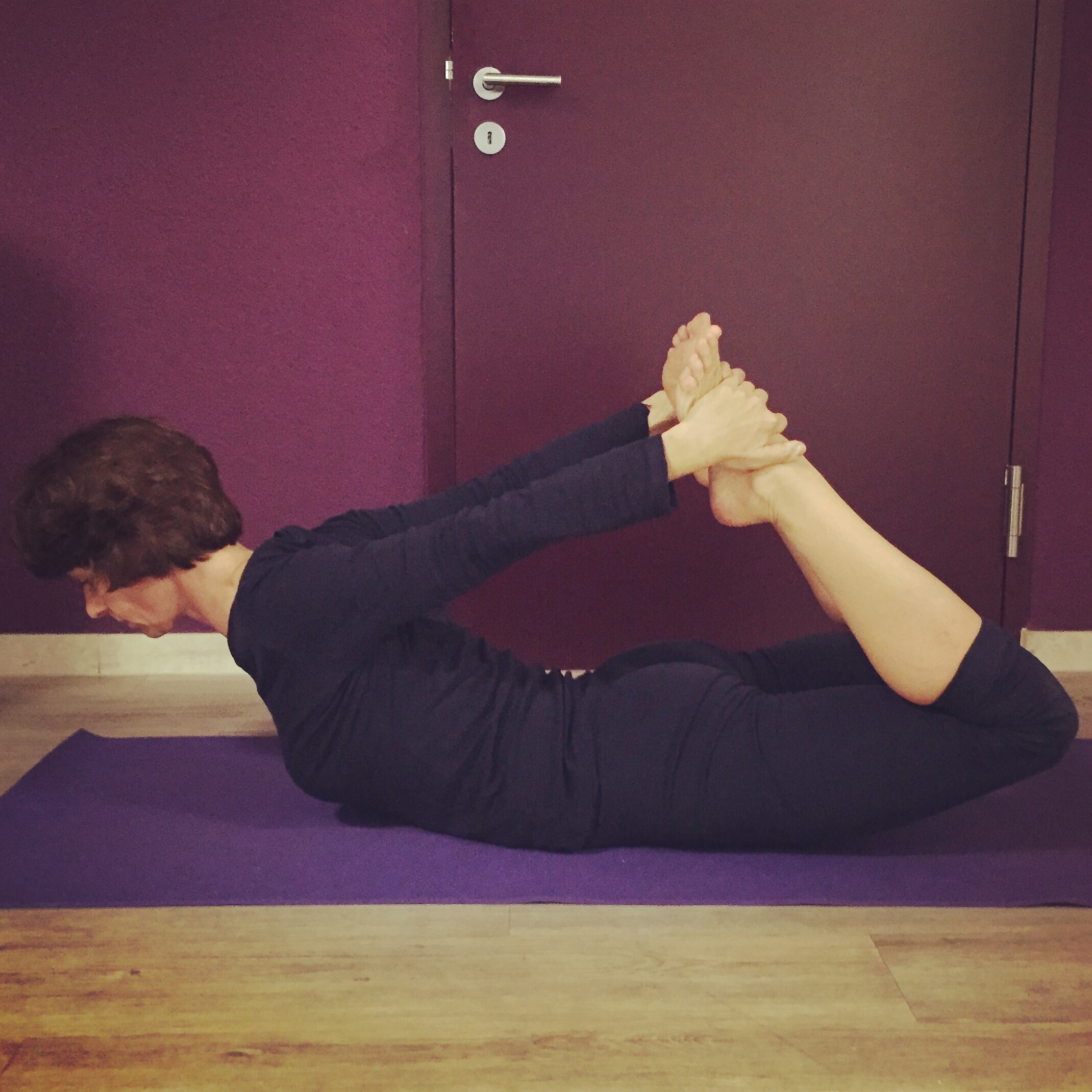
This yoga pose opens the front of your body, the breath can flow free and your thoughts get calm. It improves the general strength of your body and thus your posture. The digestive system gets a boost. The muscles of your thighs will be stretched, your belly and butt muscles strong and activated..
Blockades of the sixth chakra (the Third Eye Chakra) will be eased due to the slower flow of thoughs and we connect again with our intuition. The opening of the front side of the body activates the second, fourth and fifth chakra, too.
Lie on your belly as Barbara of Zurich’s Yotree is showing and grab your ankles with your hands. This movement automatically makes your chest and legs raise and it looks like a bow. The shoulders stay relaxed. The neck is the natural extension of your spine. Remain in Dhanurasana for a few breaths and feel self-confident. Namaste
November 28
Uttanasana (Standing Forward Bend)
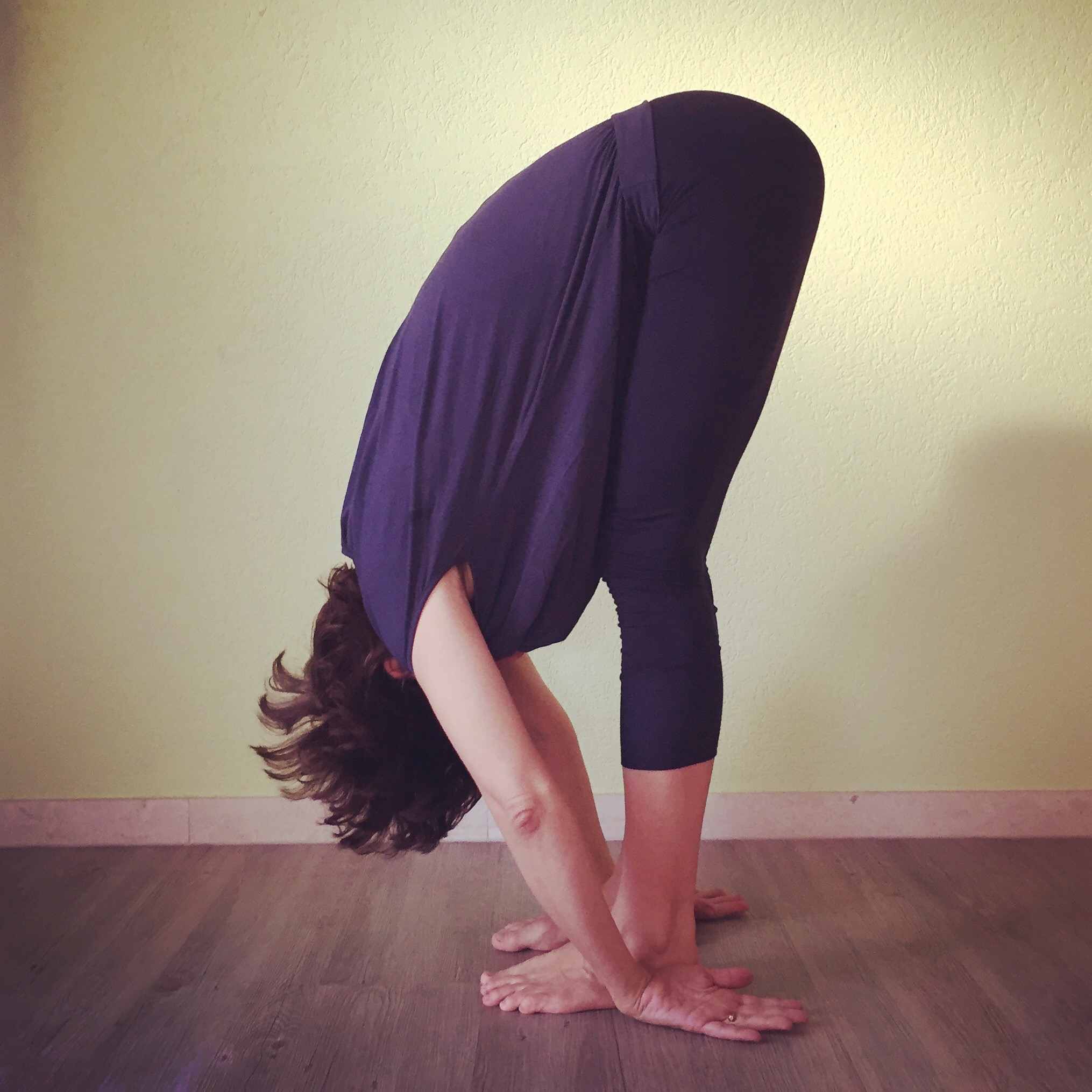
The standing forward bend is a light stretch of the lower back, the hamstrings and calves. The digestive organs, liver, and kidneys get a massage, so menstrual cramps can be eased. Whoever sits or stands a lot will love this relaxing pose. The pose can help to reduce high blood pressure, helps against fatigue, anxiety and headache, supports patience, calms the mind and is good for our nervous system, too. The total relaxation of the neck as well as the increased oxygenation into the brain, as the head rests below the heart, eases stress and light depression. Blockades of the seventh chakra, the crown chakra will get transformed by practicing this pose and the awareness for the here and now emerges.
Stand hip-wide apart and press your toes firmly into your mat or into the ground. Bend your knees lightly and then fold your upper body over your thighs. Let your neck and head hang down and put your arms around your knees, on your ankles or on the floor as Barbara from Yotree is demonstrating. Feel the energy boost in your body and mind and let your soul feel free. Namaste.
November 21
Gomukhasana (Cow Face)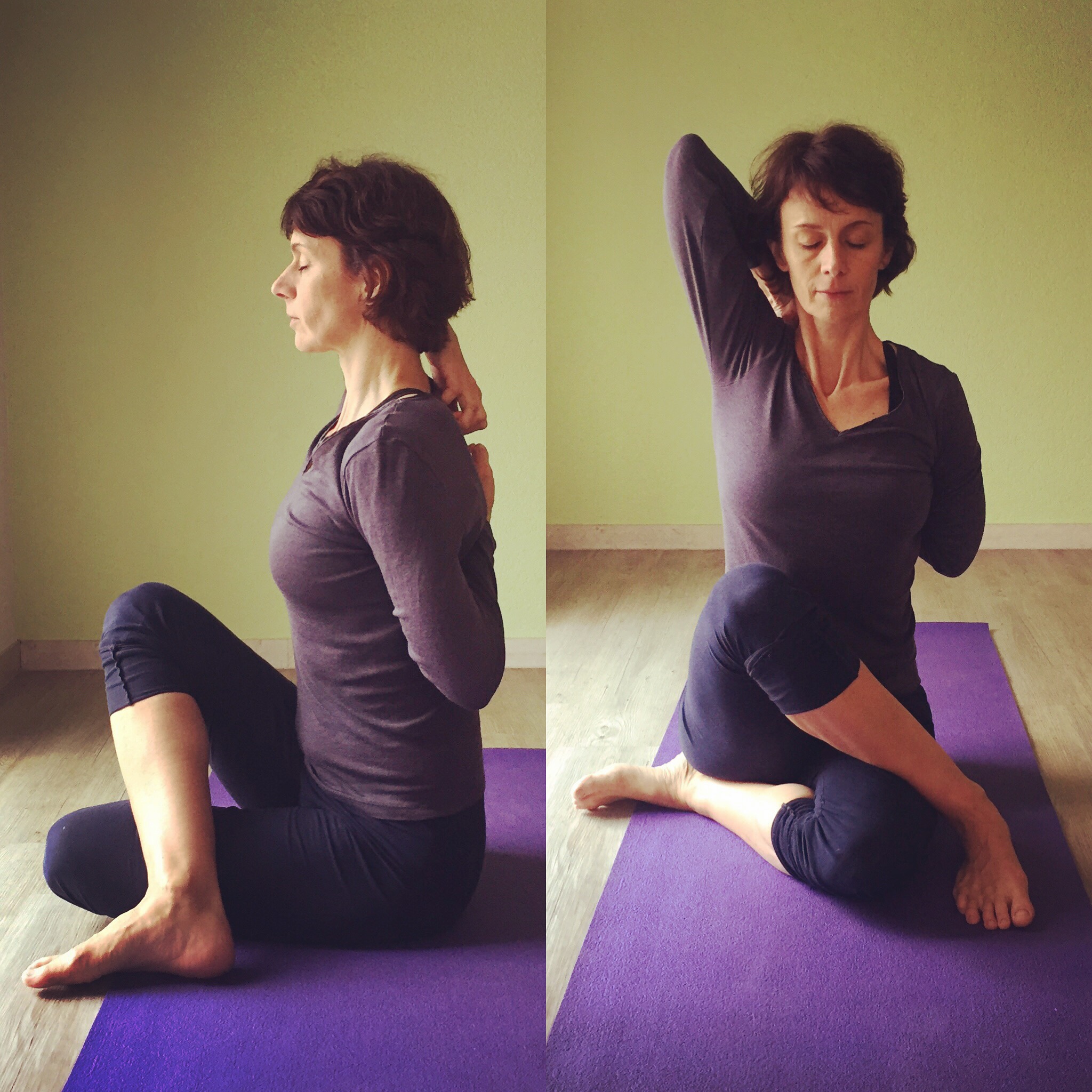
The mental bonus of this yoga pose is inner peace. The physical benefit is more flexibility in your hips, pelvis, knees and stronger arms, legs and shoulders. Also the opening of the chest and heart will ease the flow of air, breathing becomes easy.
There are yogis that see a cow face in this pose, however, it is obvious to everyone practising this pose that serenity, joy, happyness and self-confidence will improve and blockades of the second chakra, the sacral chakra such as depressive mood, creative crisis and powerlessness will be soothed.
While sitting cross-legged like Barbara, tilt your body towards the right side and put your left knee right above your right knee in order to be able to sit with your right buttock on your left heel. Put your feet, if you are not suffering from knee problems sidewards. Put your hands behind the back so they can reach out for eachother. Stretch one arm sideways then bend it and touch your back with the palm. The other hand goes straight up, them bend this one, too so they can touch eachother. The intense stretch of the chest is at the same time a deep relaxation of the shoulders. Breathe in Peace, Breathe out Love and feel the bonus of this pose. Namaste.
November 11
Garudasana (Eagle)
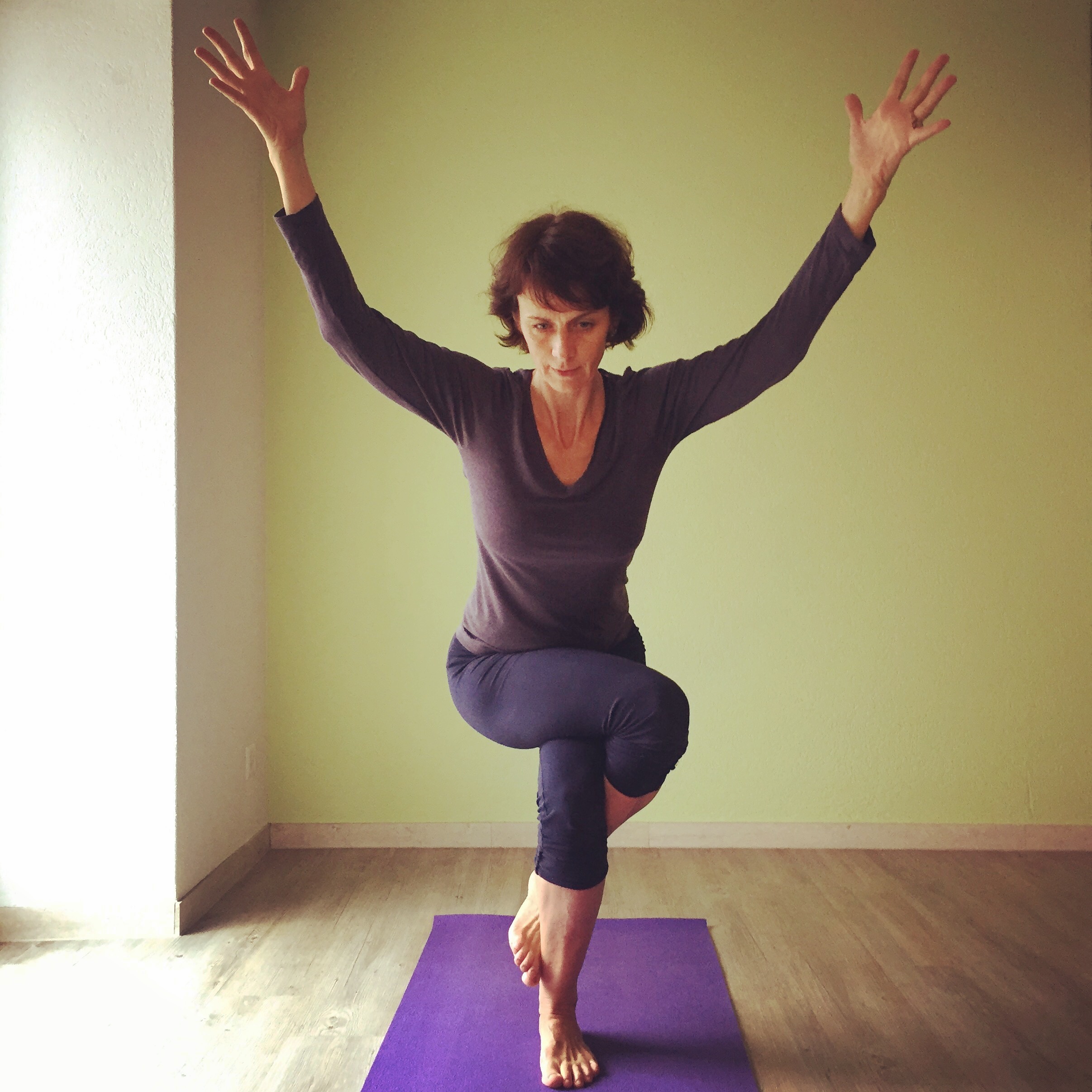
The eagle pose supports the ability to concentrate and strengthens the spine, the ankles, calves and thighs. The relieving stretch of the lower back eases possible back pain in that area. Other blockades of the second chakra, the sacral chakra such as menstrual cramps and problems of the bladder can be soothed by practicing the eagle pose, too.
Feel free and powerful like an eagle by winding one leg around the other while standing. Your torso remains straight and your gaze focused. Put your hands into the prayer position or spread your wings (arms) towards the sky as Barbara is showing by practicing one of her favourite yoga pose. And now, feel this freeing and powerful energy of this asana. Namste.
November 6
Parsvottanasana (Pyramid)

Pyramid pose, or intense side stretch pose, is an intense stretch that strengthens the thighs, joints and abdominal muscles and stretches the spine, ankles, hamstrings, shoulders and hips. It also improves the practitioner's sense of balance and posture. The pose activates the abdominal organs, stimulates the digestion and helps to boost the positive energies of the first chakra (root chakra).
The flow of blood to the brain, head and neck improves, as well as the sense of balance. The pose can help to reduce migraine and insomnia as she calms the mind.
Take one big step back to come into one of Laurie’s favourite yoga poses. The legs are straight and the spine is as long as possible. Roll your shoulders towards each other to open your chest. Fold your body over the front leg and put your fingertips or palms on the mat or for an even more intense stretch turn your hands backwards as Laurie (LA Lady Yoga) is showing in the picture. Take some breaths. Namaste.
November 2
Matsyasana (Fish)

People sitting on a desk most of their working time will benefit a lot from the fish pose as the deep stretch of the spine and as well of the abdominal muscles into the opposite direction of an ordinary sitting position are feeling so good. The chest opening is another plus of this pose. People suffering from respiratory ailment and those with digestion problems and menstrual cramps will find this pose is easing their problems, too. The fish pose is said to activate the Heart and Throat Chakras and transforms blockades of the Third Eye Chakra.
Lie on your mat as Barbara is showing and place your hands under your buttocks and roll your shoulders towards each other. Then lift your chest while your head (crown or back) still touches the floor. Your legs are stretched out if possible. Namaste.
October 24
Utkatasana (Chair)
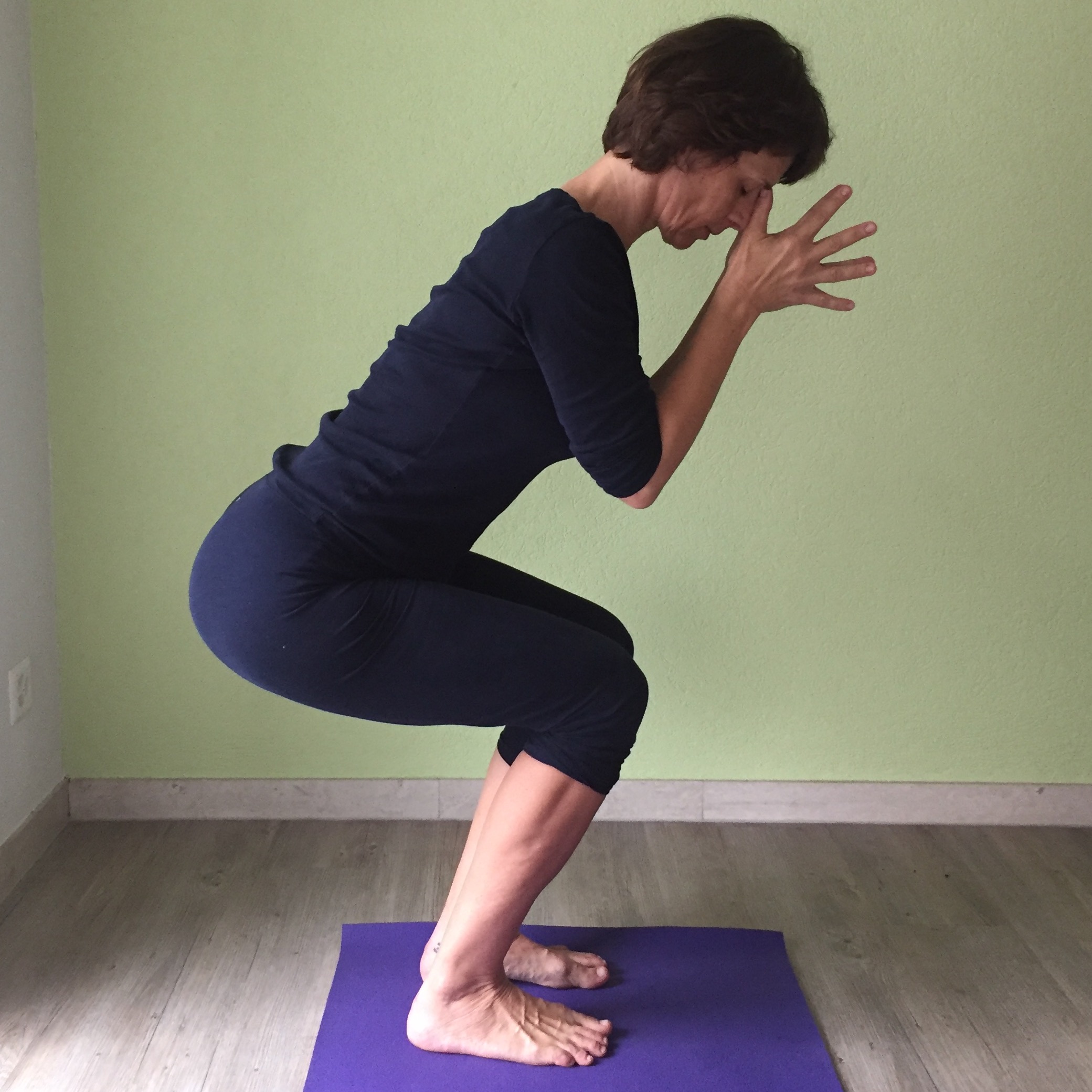
The so-called chair pose strengthens your thighs, ankles and knees and your arms and shoulders profit from this powerful asana, too. Your body tonus in general benefits from this pose. Blockades of the first chakra (the root) such as anxiety, loss of confidence in oneself and others or depression can be eased. Energy frees from the center of your body, positive energies of the third chakra (the solarplexus) such as willpower, faith and a fire of joy will be activated. Utkatasana helps against low blood pressure, insomnia and headache and boosts your endurance.
As in tadasana (mountain pose) your heels are tightly connected to the ground, you bend your knees and tilt your pelvis a bit as if you sit on an imaginary chair. Keep your lower back as long as possible and breathe naturally and relaxed. Lower your tailbone for strengthening (especially in your thigh muscles).
You can raise your hands, put them straight out in front of you or form an Anjali Mudra as my yoga teacher Barbara is doing. Namaste.
Anjaneyasana (Low Lunge)
Put one leg as far to the back as possible. The knee of the front leg is placed excatly above the that heel as Laurie (Lady Yoga) is showing you. Upright body /chest and hands above your head. Keep this pose for several breaths and enjoy the energy.
Pashimottanasana (seated forward bend)
Sit on your yoga mat as shown by Barbara of Yotree with stretched legs and try to reach your toes, your heels or ankles while tipping over your hips and bending your upper body. Enjoy this intense stretch. Namaste.
Jathara Parivartanasana (supine twist)
This pose enhances the free flow of the energies of the third (navel) and fourth (heart) chakras.
Lie on your yoga mat and bend your legs like my yoga teacher Barbara is doing. Put your arms next to your body, palms up. Let your shoulders sink into the mat, place your knees on one side and your head opposite. Relax and feel the energy. Namaste.
Virabhadrasana 2 (Warrior 2)
Especially the first chakra (the root) gets stimulated, as you feel grounded and the inner stability which is essential for personal growth gets a boost.
You strenghten your shoulders, arms, legs and abdominal muscles, you open your shoulders, chest and lungs and you stretch your thighs. The body strenght and your resilience improves and you gain bravery.
Practise Tadasana (mountain pose), then put your left leg like Barbara is doing to the back and rotate your foot outwards. Both heels have to build one line. Turn your hips towards the left a little, bend your right leg until your right knees is exactly above your right heel. The arms are parallel to the floor, palms down. Open your shoulders and chest and focus the horizon. Stay in this pose, gracefully like a hero or warrior for a couple of breaths and feel power, courage and self-confidence raising. Namaste.
Shavasana (Corpse pose)
Shavasana relaxes the whole body, the pose harmonizes the flow of energy and calms the mind. The longer you do the pose, the slower your pulse and breathing and the clearer your mind will get. Especially blockades of the first (root) and fourth (heart) chakras can disappear when you remain for some time in this pose. The touch with the mat/floor helps to feel grounded again.
Lie down on your back and open your legs hip-wide and let your feet fall towards the outher side. Put your arms next to your body, palms facing up, as shown nicely by my yoga teacher Barbara of Yotree in Zurich. Close your eyes and totally relax your body and face. Imagine getting heavier and heavier and sink completely into your mat. If you like, you can do a body scan or while inhaling you think of an affirmation and while exhaling you let that affirmation go. Before you dive into the here and now again, loll and do a full stretch of your body, then sit up and open your eyes slowly again. Namaste from Mumbai.
Apanasana (Kness to Chest)
Lie on the mat and pull your knees to your chest. Put your arms around your shin or do it as my yoga teacher Barbara and put your hands on your shins. Relax and refresh and have a good start into the new week! Namaste!
Baddha Konasana (Cobbler)
Both poses though serve as hip openers and are good for the stretching of your upper thighs. It is very helpful for pregnant women as this hip opener is ideal for ante-natal preparation. In general these poses are great for meditation, too as they cost neither strenght nor concentration.
Especially with blockades of the first chakra (root chakra) Supta Baddha Konasana has a positive effect in lying down and ground your body.
If you are doing this pose sitting (Baddha Konasana), then you stimulate the energies of your second chakra, your sacral chakra. The sexual reproductive system, especially your ovaries and menstruation will be regulated. The back profits from this pose, too as the stretching feels so good for it.
These yoga poses beat bad mood, stress and fatigue.
Barbara sits on the mat with both soles together, both knees on the sides. The round back is flexed forwards, the hands next to the body or around your toes.
Supta Baddha Konasana is similar to Shavasana but with bent legs. Relax and namaste!
Tadasana (Mountain)
Barbara of yotree stands firmly on the mat, her weight is evenly put on both feet, the middle is strong, the shoulders are relaxed. The arms are either raised above the head or stretched along the sides of your upper body. Fix a point with your gaze above your head or at the horizon. Feel grounded and keep this pose for several breaths. Namaste.
Sit firmly with both legs on the ground then you put your right leg over your left leg. Clinch your left arm around your right knee or thigh or stretch it towards the sky as my yoga teacher Barbara does on this picture. Place your right hand behind your butt while you turn your head and body towards the right side. Relax your shoulders and neck but make your back as long as possible. Keep this pose for several breaths and try to twist with each breath a little more towards the right side. Slowly turn towards the center before you change sides and do this spinal twist towards the left (change position of legs and arms, too). Namaste and sleep deeply!
Balasana (Child Pose)
Especially when one feels anxious and vulnerable this pose is pleasingly comforting.
You sit, as my yoga teacher Barbara of yotree on your heels while your forehead touches the yoga mat. Your hands may be strechted in front of your head or you can lay them closely next to your body. The Child pose boosts the energy of the fourth, our heart chakra and can ease blockades of the Crown chakra, our seventh chakra. Feel free, connected to yourSELF and open-hearted as a child. Namaste!
Down facing dog, as shown by my yoga teacher Barbara of yotree equals an upsidedown V. The fingers are flexed, the back relaxed and straight. The rear has to be pushed up, breathe deeply in and out and hold the pose.
Adhomukhasvanasana opens the chest, eases the breathing and strenghtens the heart. This on the other hand freshens your mind and gives you energy for your soul. The energy of the fifth chakra, your throat chakra gets a boost, too. Also the third chakra (Solarplexus) and the sixth chakra (Third Eye Chakra) profit from doing this pose. Maybe that is a reason, why this pose is so super popular in various yoga studios around the globe!
While holding this pose, the muscles of the arms and the shoulders will get stronger. The easing stretching of the back, the backside of your tighs and calves can be beneficial in helping your nervous system to calm down and the pose even helps in case of insomnia. Get into an inverted V and get a different perspective, Namaste!
August 11
Natarajasana (Dancer)The dancer's pose supports your general healthiness, gives you a clear mind and strenghens your ability to cope with pressure dealing in mental tasks. The pose requires a good balance and concentration. Your legs get a boost and there will be an opening of your chest, the lungs and the shoulders.
The energies of the sixth chakra, our Third-Eye-Chakra, will flow freely and be more powerful. Blockades of the Heart Chakra, our fourth chakra, can get eliminated. If you feel lonely, isolated, detached of your feelings and lovelessly the dancer's pose can help to harmonize body, mind and soul and to embrace yourSELF again.
Feel grounded and put both legs firmly on the ground, then bend one leg and clasp with the same hand the foot. Stretch the opposite arm upwards, then move forward and lenghthen your upper body as shown by my yoga teacher Barbara.
Take some deep breaths and try to fix your gaze on one spot in the front to support your balance. Namaste!
August 6
The stretching of the upper body helps to strenghten the muscles of the back and the rear and helps for the flexibility of the spine. The organs of the belly (the middle) get stronger, too.
The pose makes you awake and lowers stress (contradicting its sheer name, which I guess raises stress levels in many of us) and your ability to concentrate rises. The female energy (creative powers) awakens and so is this asana helping to boost the energy of the second chakra, the sacral (or pleasure) chakra.
While on your stomach, your elbows are tight next to your body, directly below your shoulders. The palms face the ground and then you activate your pelvic floor, pull the belly button towards your spine and then push slowly with the help of your stomach muscles your upper body including your head (with a long neck) towards the sky.
Your hips remain tightly on the ground, the legs and feet form a tail like the one of a cobra. The pose then looks like an attacking snake.
If you face back problems, you can do a baby cobra, as shown here by my yoga teacher Barbara. As she does not push her upper body too much towards the sky, her back is not as bended as doing a full cobra, therefore there is less stress on your back. Namaste!
August 3
The tree pose looks so easy but depending on your ability to focus and concentrate, you can look like a mighty oak tree or swinging back and forth like a bambus tree on a monsoon day... This pose is excellent for your (inner) balance and helps to get focussed and be concentrated.
The whole body needs to be strong and all muscles are needed to stay in this pose. Especially the thighs, the calves, the back and stomach get a boost. You open your chest and breathing (and relaxing) becomes easy.
The tree pose stimulates the sixth chakra (the third eye chakra), thus the fantasy, intuition and the connection to the spiritual world. It also connects you with your first chakra, the root chakra, as you get rooted to the world as such.
Barbara from Yotree shows how Vrksasana looks like. The foot of one side touches the thigh of the other if possible, never let the knee to be touched, if the thigh is impossible, reach for the lower leg. Fold your hands and stretch them out above your head. Relax & balance and feel strong as a tree. Namaste!
July 26
Baby dog, melting heart pose or full cat stretch are different names for Anahatasana. This pose is an ideal counterpose to the child pose as it is a gentle bend for the lower, middle and upper back. The heart as well as the shoulders profit from the stretch and the circulation gets a boost aswell. The pose enhances mental energy, stimulates serenity and as the name (anahata = heart) presumes it also helps to open the heart chakra.
My yoga teacher Barbara (yotree in Zurich) shows how to get into the pose:
From the table position put your arms and hands in a V, then lower your chest towards the ground until your forehead touches the mat. The hips remain above the knees and the highest point of the body is the butt. Relax, let go and feel the serenity!

